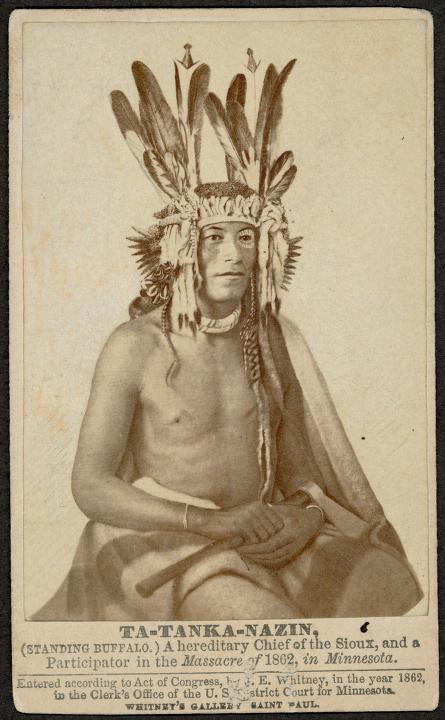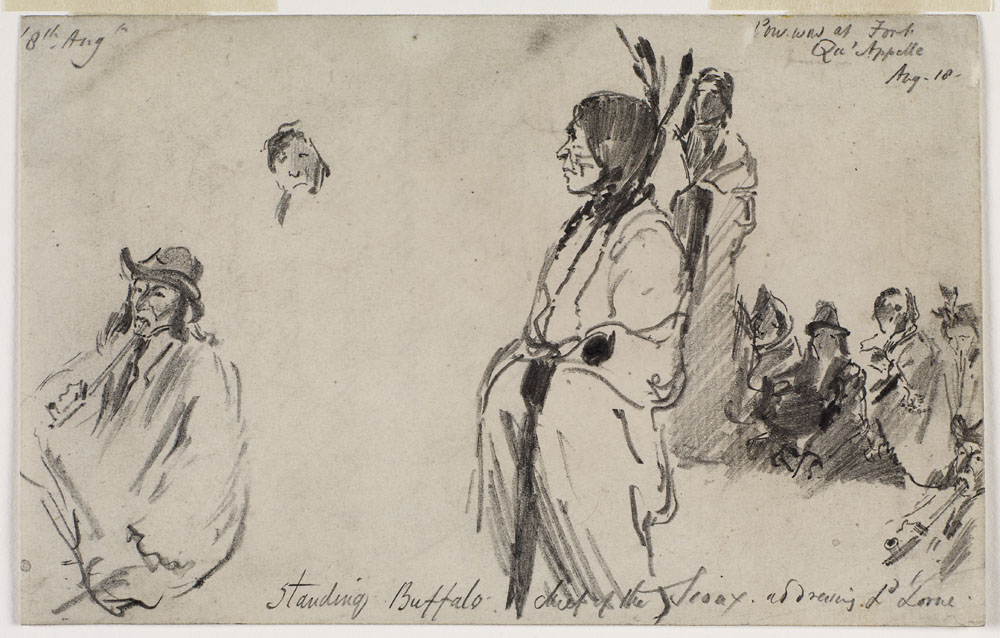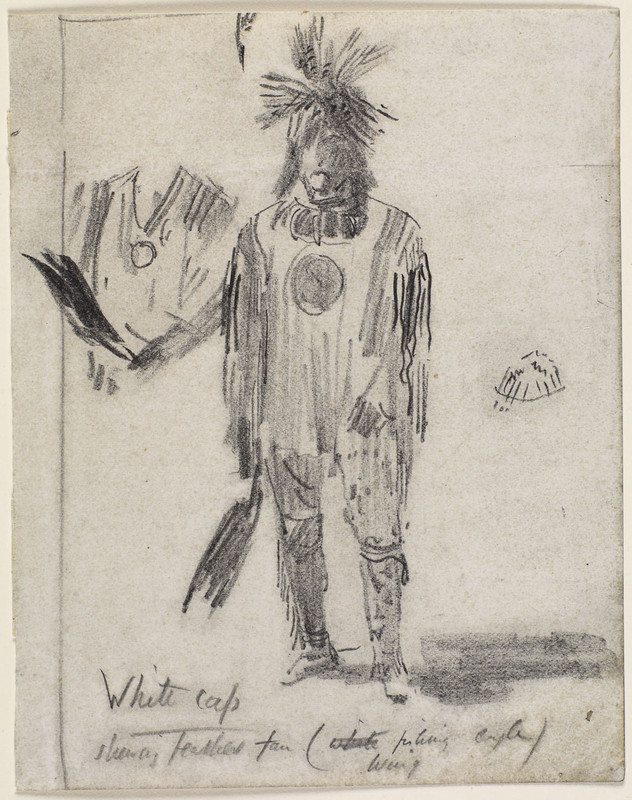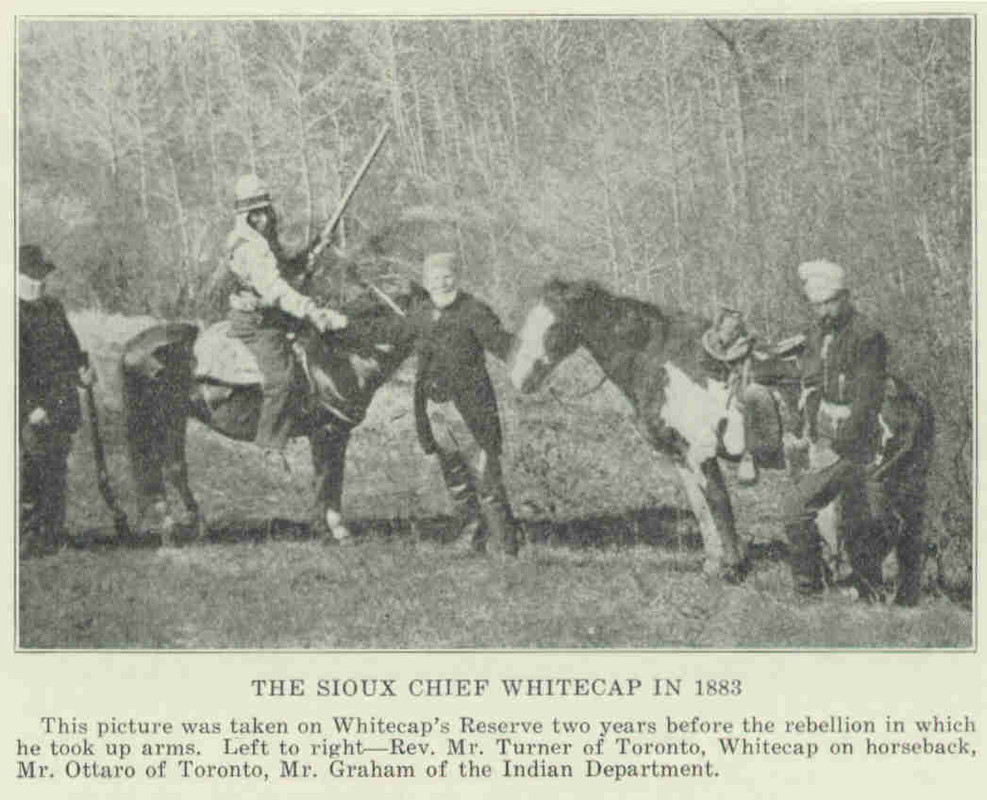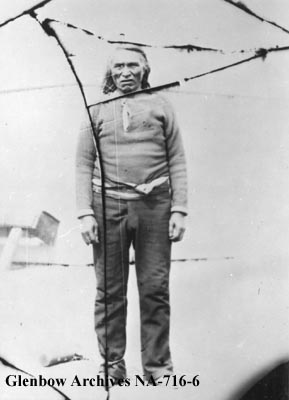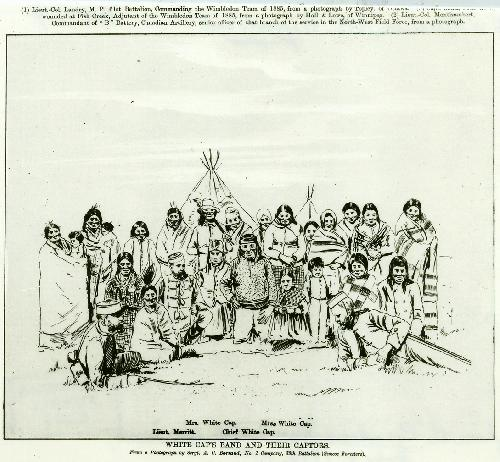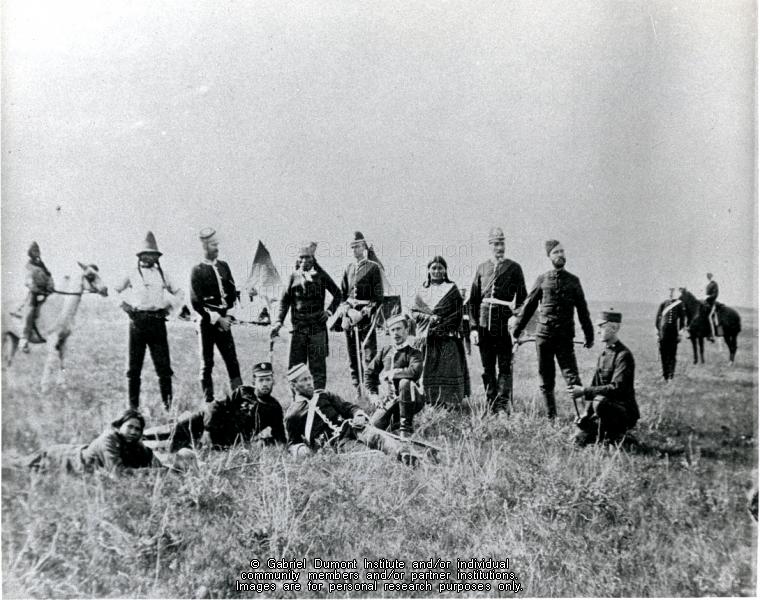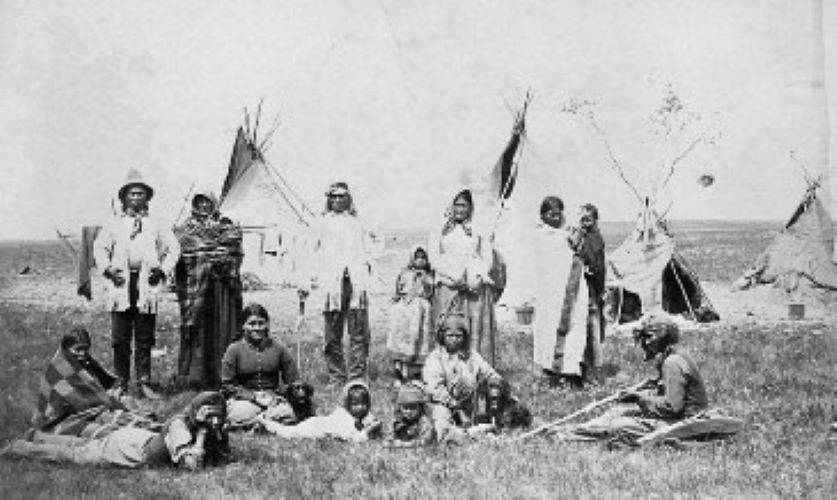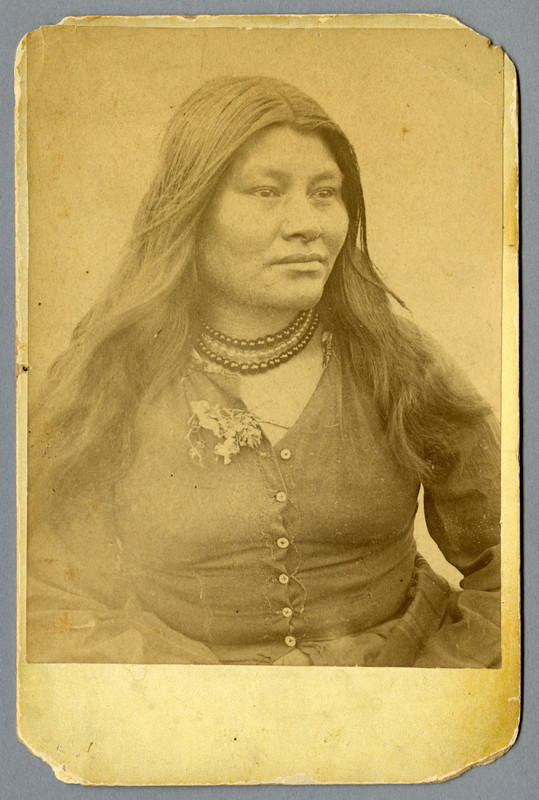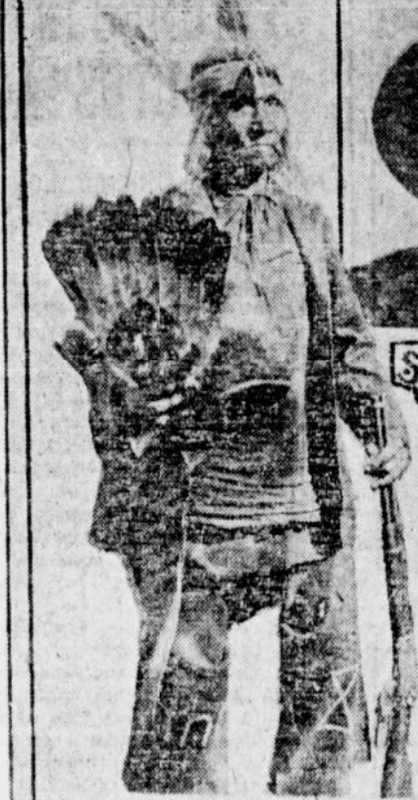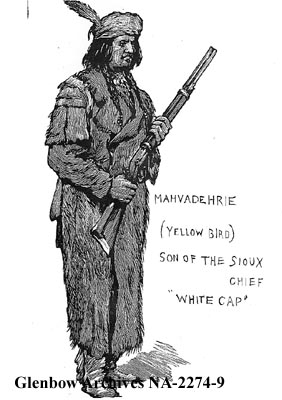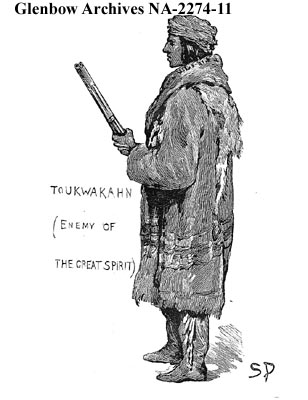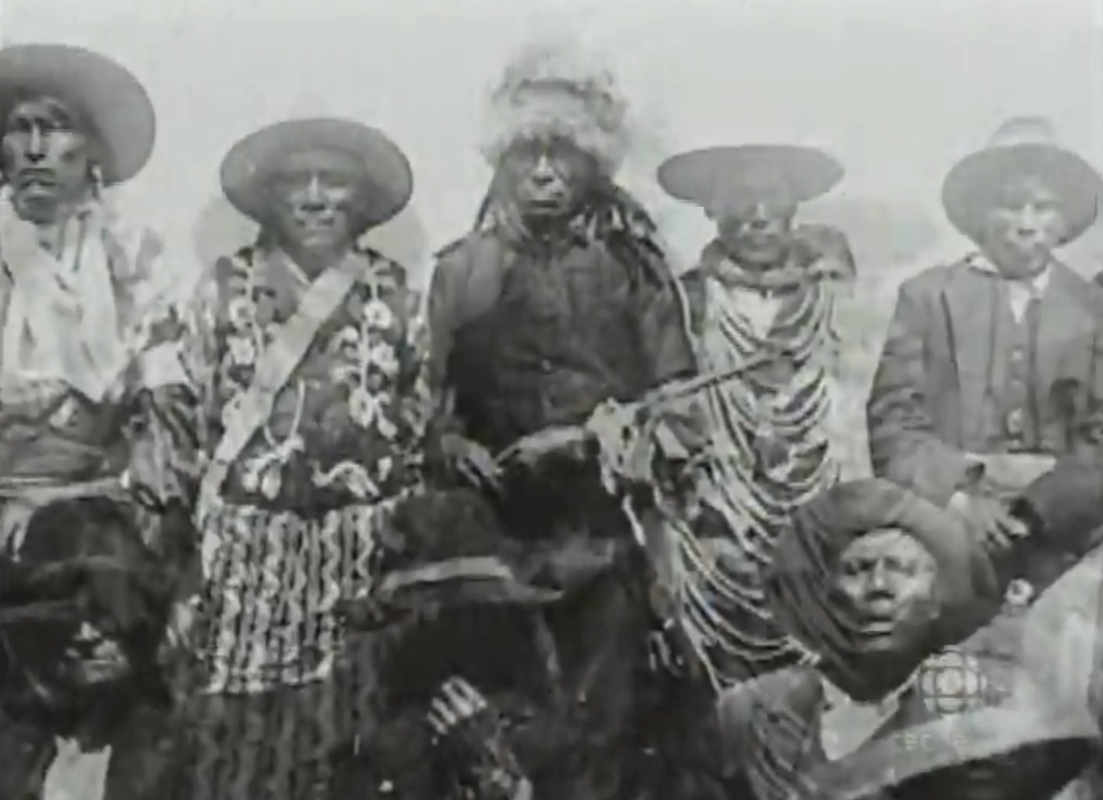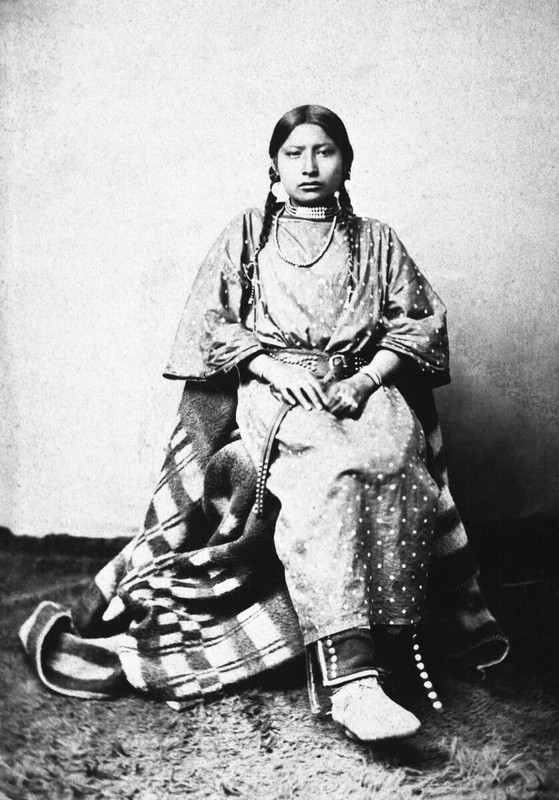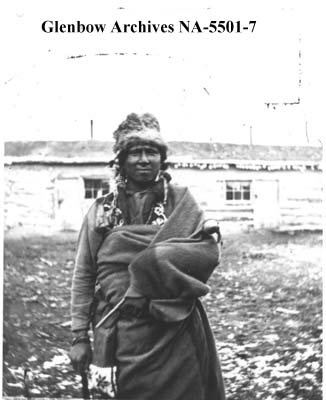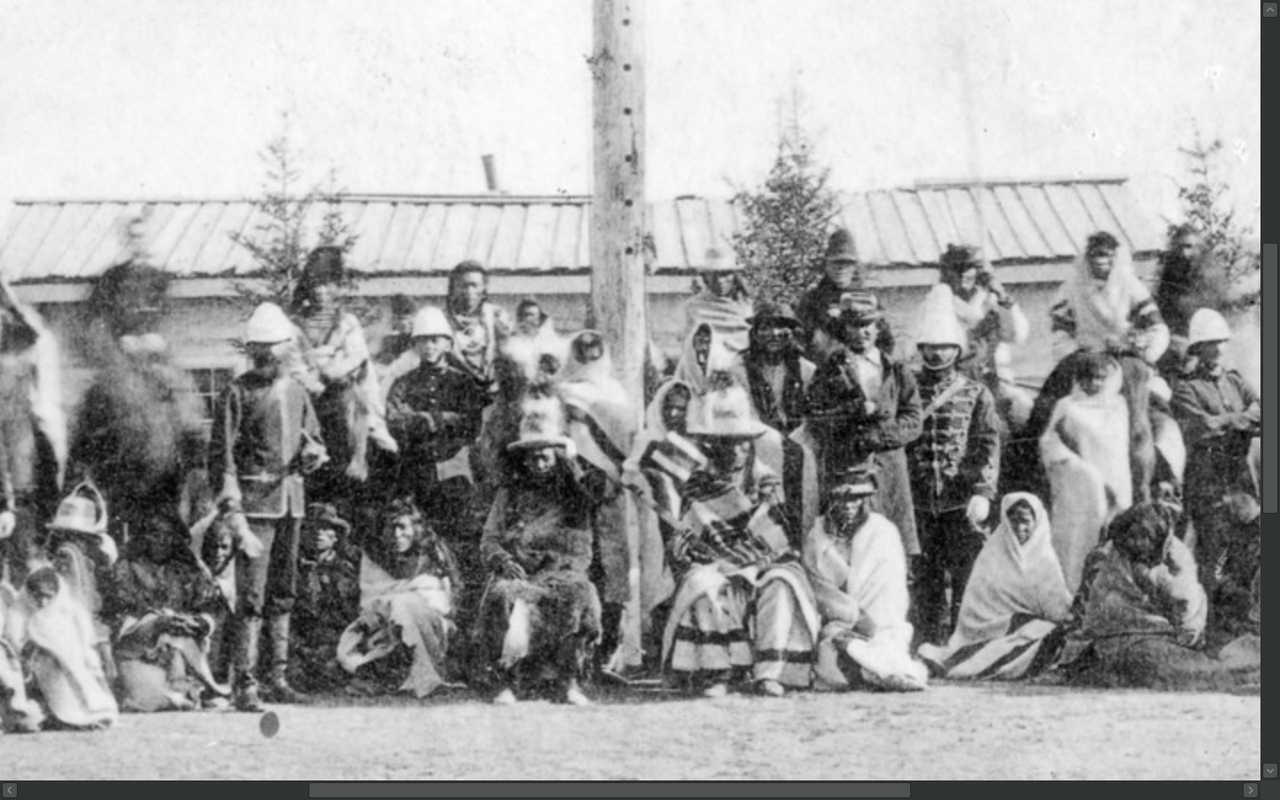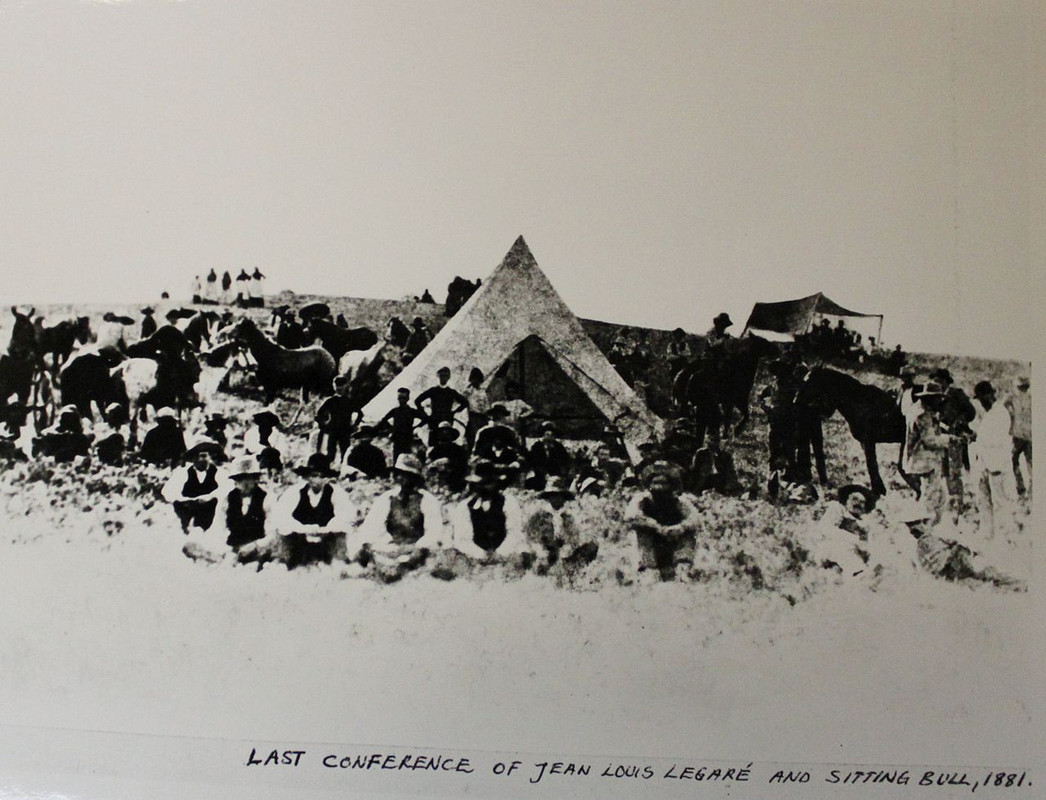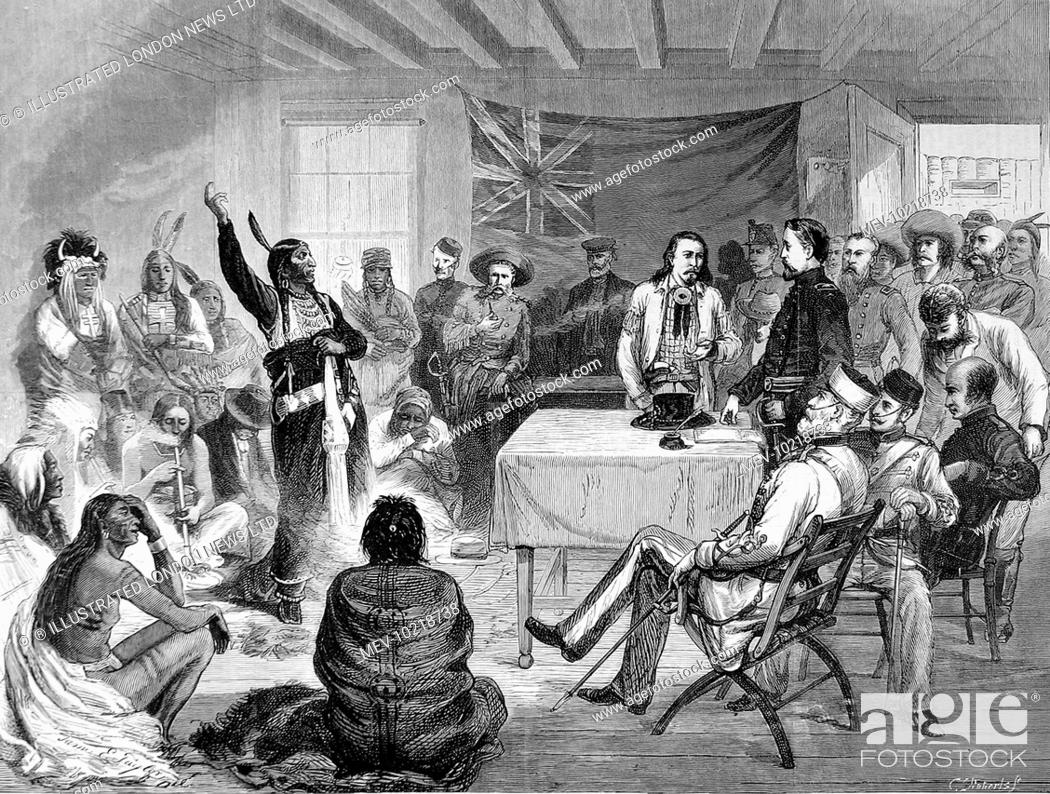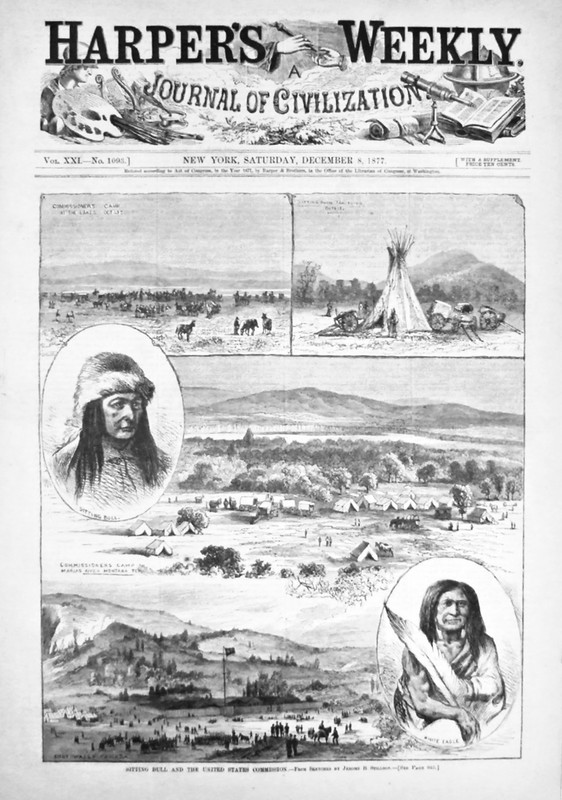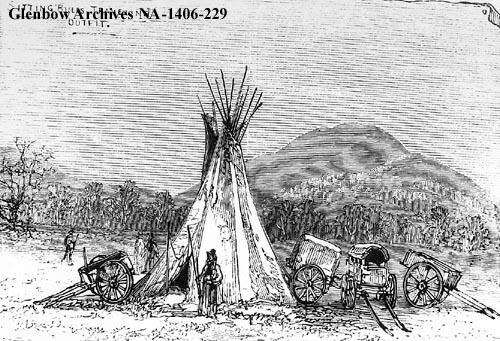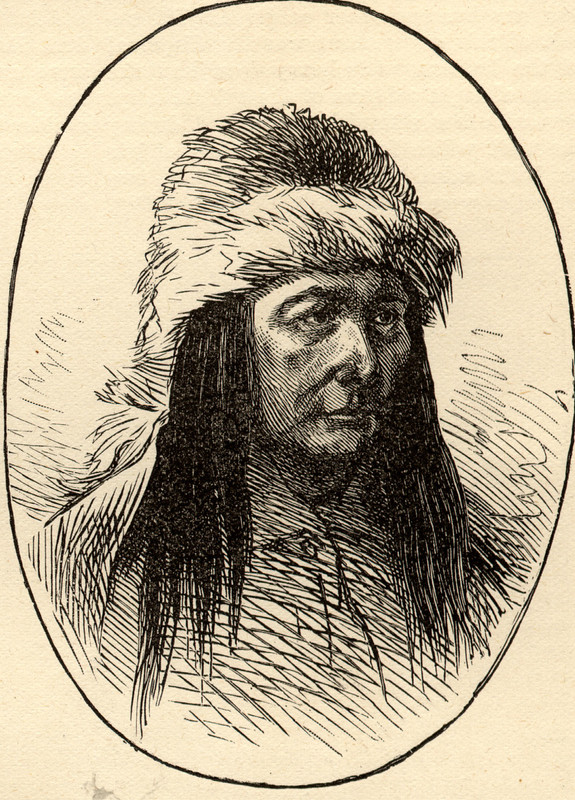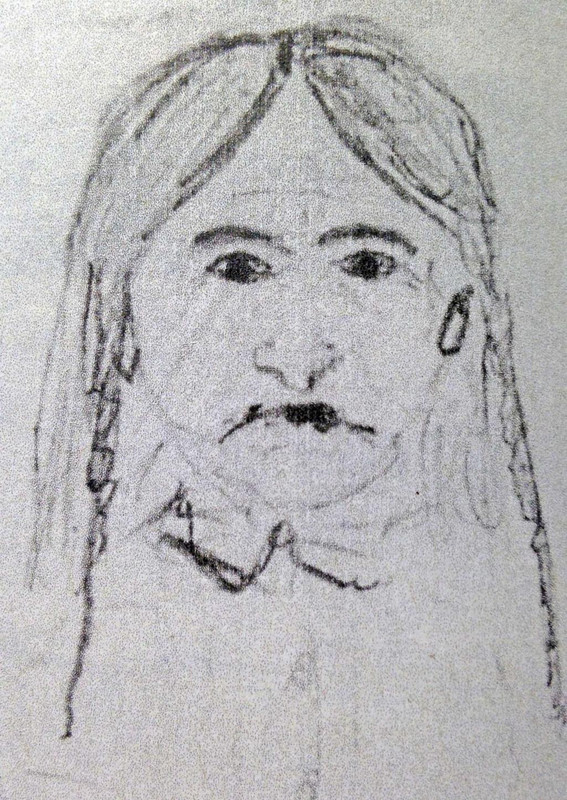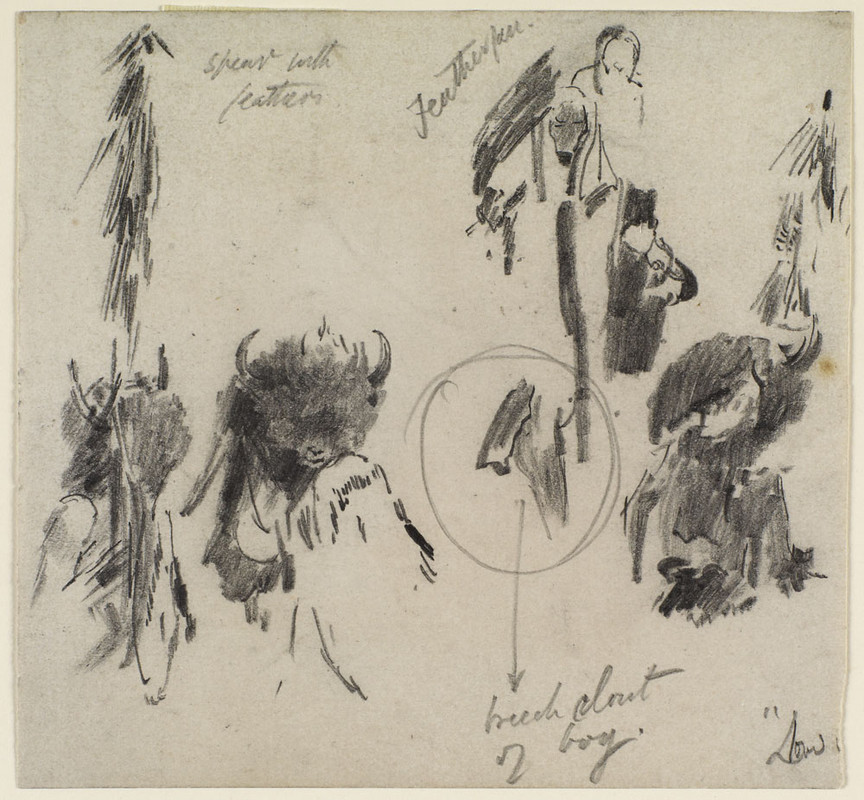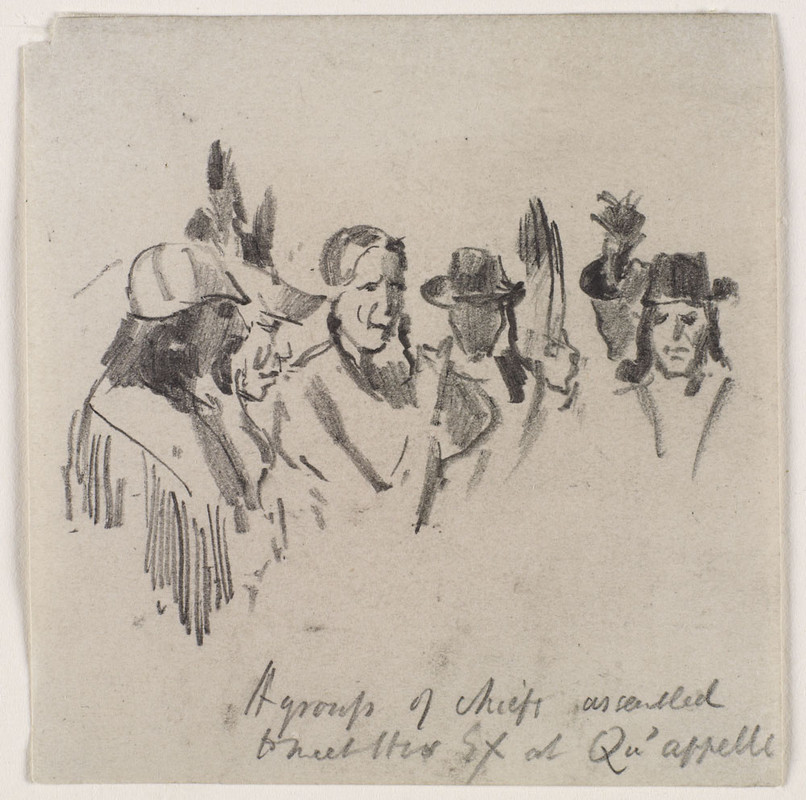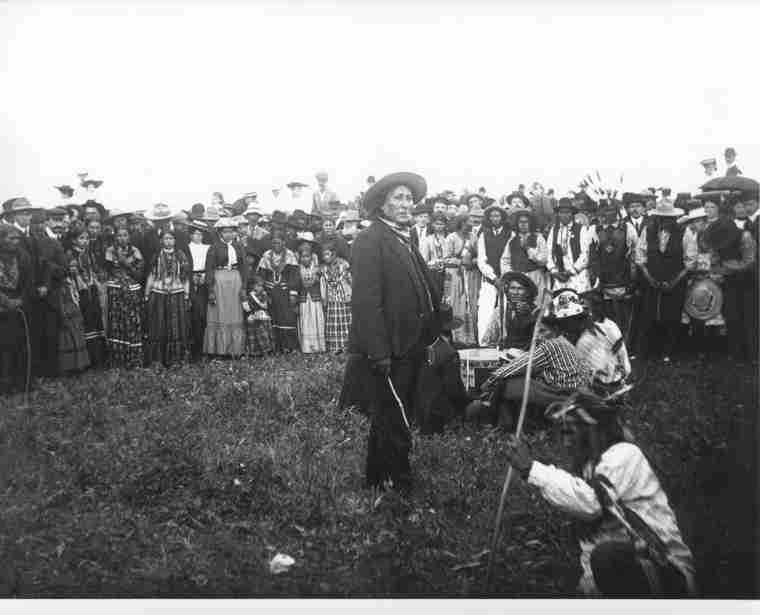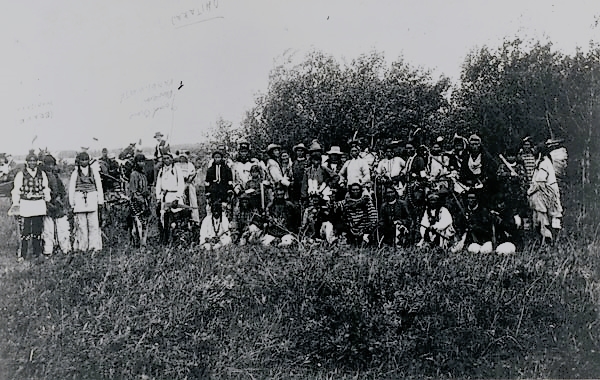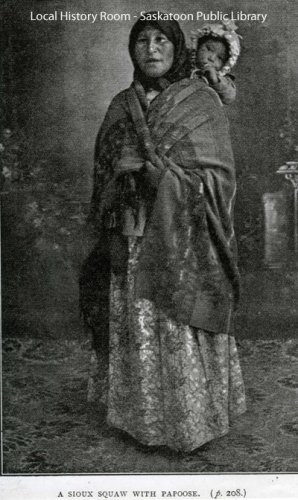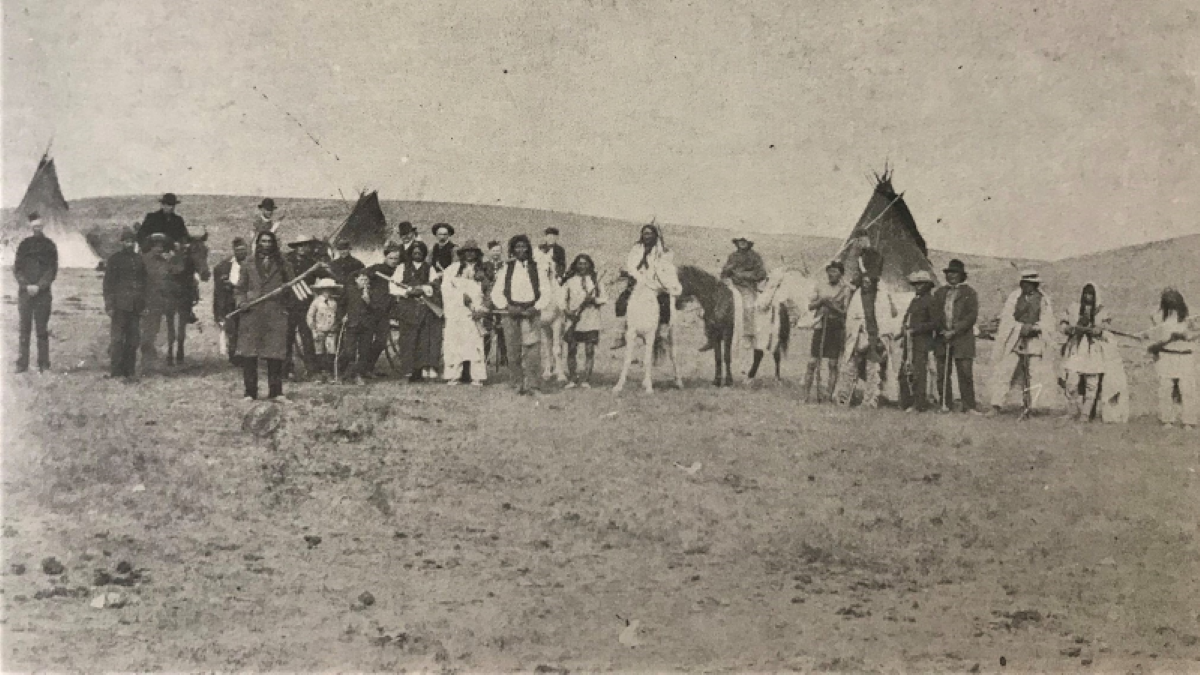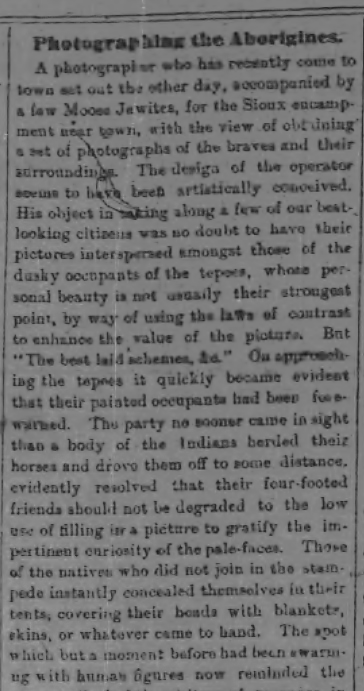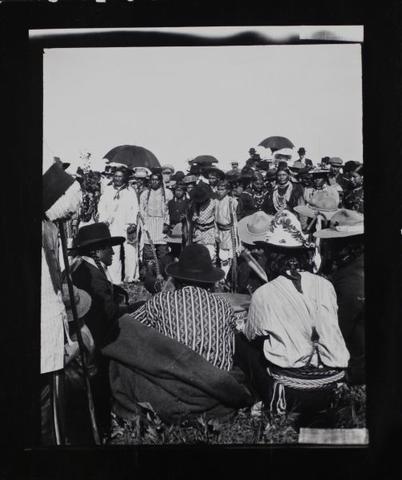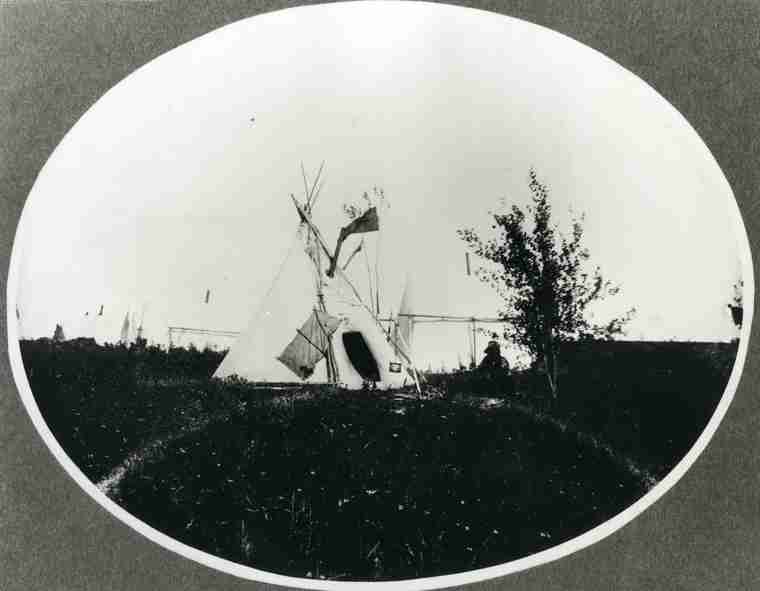Dakota and Lakota in Canada - Visual Images
Apr 14, 2022 12:58:13 GMT -5
chicheman and wanbli ahitunwan like this
Post by grahamew on Apr 14, 2022 12:58:13 GMT -5
The 'Sioux' in Canada - in photographs, circa 1870 – 1915 – Part 1
This is a selection of photographs of Dakota/Lakota people in Canada, taken largely between 1870 and 1915. Most of them aren't in any sense rare - quite a few can be found at The Glenbow site ( digitalcollections.ucalgary.ca/asset-management/2R340826N9XM?WS=PackagePres&Flat=1&FR_=1&W=1280&H=569 ) - and it’s by no means complete; documentation is often poor, hence the use of the word, 'Sioux,' in inverted commas and sometimes even that might not be correct. Where subjects are named, I’ve simply used the spelling as given. On top of that, many of the people, more especially females, are, unfortunately, not named. Perhaps this is a result of 'Indians' being seen at least initially, as exotic subject matter for the photographers to sell. Canadian photographers Hall and Lowe, for example, advertised 'Indian photos (taken from life), Xmas cards, views of Winnipeg.'
To give an example of how little care was taken in terms of naming subjects correctly, this is The Evening Journal from May 1886, a year after Otto Buell had photographed the Crees, Big Bear and Poundmaker, and the Dakota, White Cap, at their trial - yet the image used to illustrate Poundmaker has been taken from a Goff or Haynes photograph of a Lakota (or possibly a Yanktonai)...
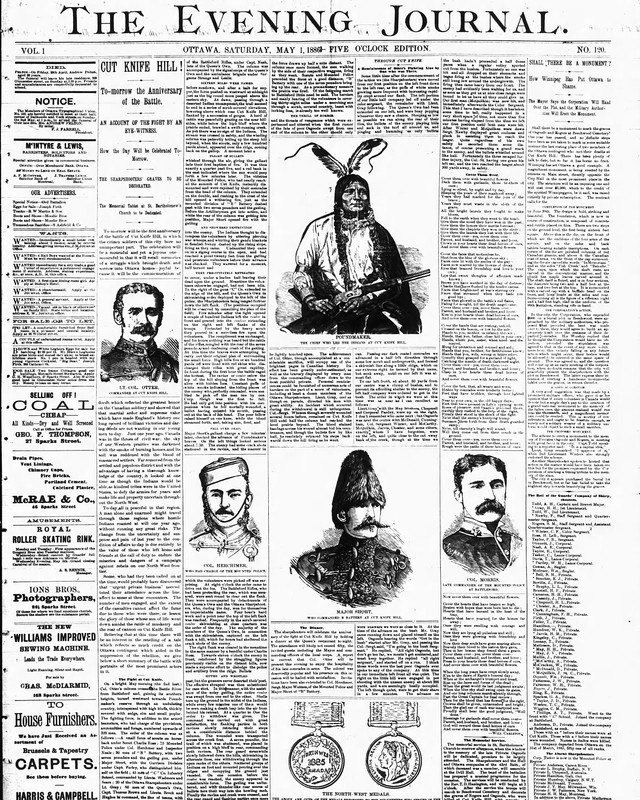
It's not even as if he looks anything like Poundmaker:
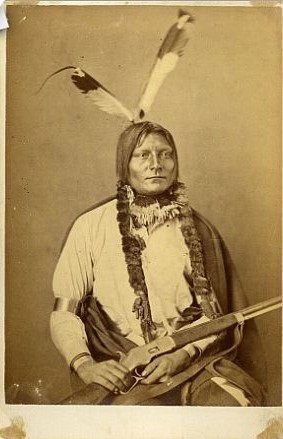
The Goff or Haynes photo

The real Poundmaker
The names of some of the photographers are unknown so it's not always possible to come up with even a rough date for some of the pictures.
Having said all that, however, here they are (along with the odd painting and drawing)...

Two 'Sioux' at Fort Garry, Winnipeg; painted by Paul Kane, 1846.
Although usually considered to be 'American,' the Dakota/Lakota wandered back and forth between the United States and Canada for many years before the exodus following Little Crow's war to hunt, trade and fight.
David McCrady's dissertation on which he based his book, Living with Strangers: The Nineteenth Century Sioux and the Canadian-American Borderlands, can be found in pdf form here: www.collectionscanada.gc.ca/obj/s4/f2/dsk2/tape17/PQDD_0027/NQ32884.pdf
Katie Pollock's dissertation that looks at the history of the Metis and their relationship with the tribes in the 'borderlands' of Canada and the USA: From Borderlands to Bordered Lands: The Plains Metis and the 49th Parallel, 1869‐1885: www.academia.edu/11090653/_From_Borderlands_to_Bordered_Lands_the_Plains_Metis_and_the_49th_parallel_1869_1885_M_A_Thesis_History_and_Classics_University_of_Alberta_2009_
Delia Lee Hagen's dissertation, Northern Plains Borders and the People in Between, 1860-1940:
digitalassets.lib.berkeley.edu/etd/ucb/text/Hagen_berkeley_0028E_15256.pdf
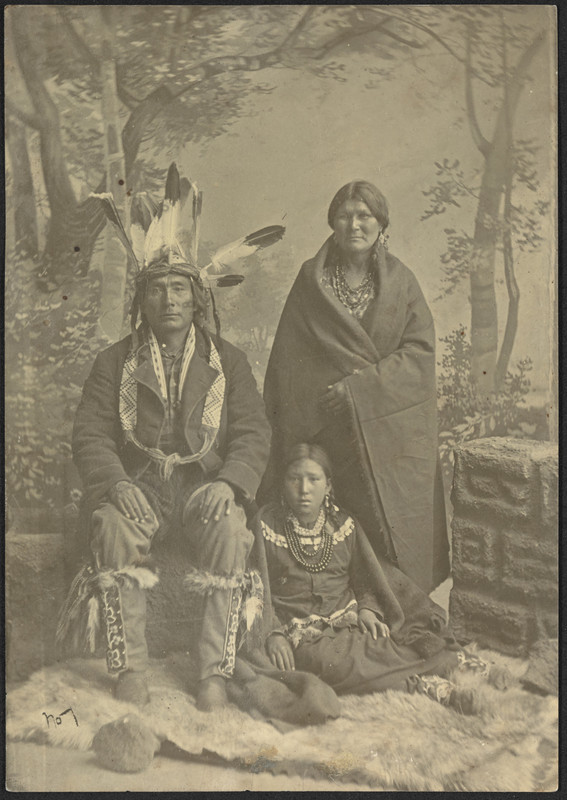
Unidentified Dakota family. Photo by J.A. Brock and Company, Brandon, Manitoba, probably between 1883-1889. However, I’ve seen the same image credited to the Davidson Brothers, also of Brandon, but they didn’t start their business until 1892 so it could well be a later date.

Iron Buffalo, Wahpeton - taken at Prince Albert by Theodore Charmbury, circa 1905.
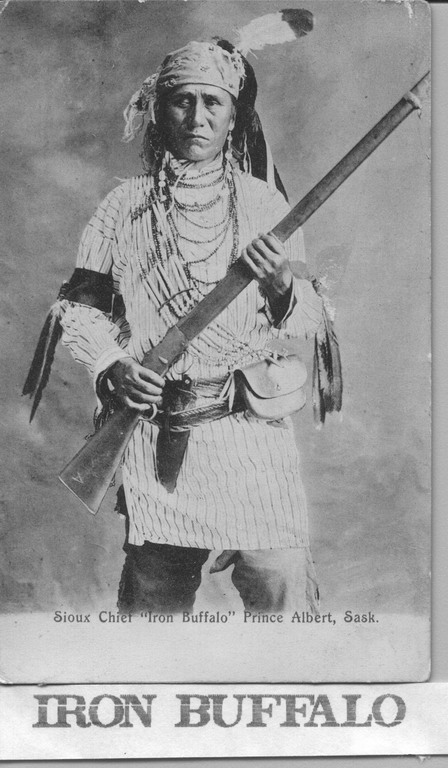
Iron Buffalo - as above.
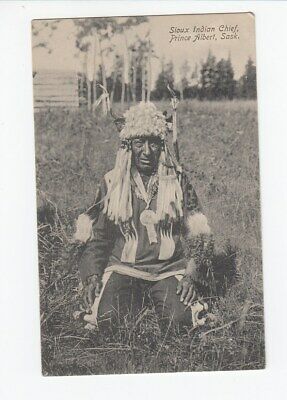
"Sioux" chief, Prince Albert, early 1900s.
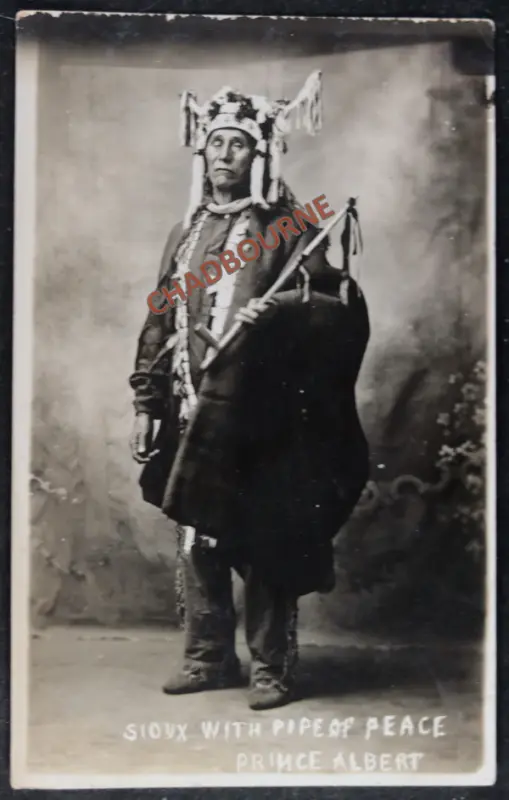
Dakota with pipe of peace, Prince Albert, early 1900s. I think this is Iron Buffalo again.
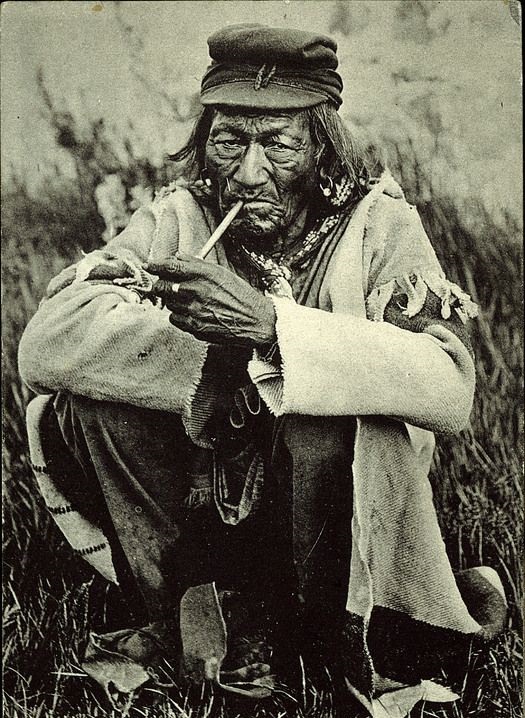
'Sioux' medicine man at Qu'Appelle.
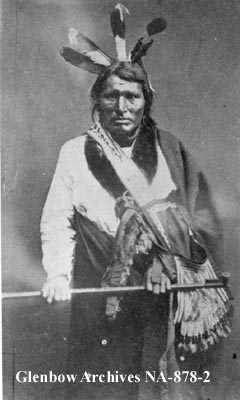
Unidentified - Red River Dakota, Manitoba; taken by Simon Duffin of Winnipeg, between 1873-1888.
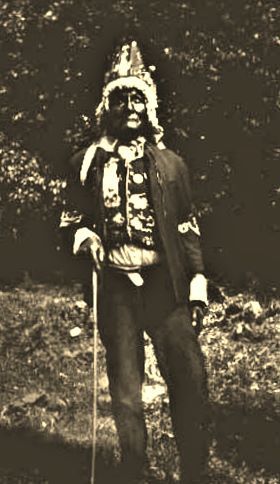
Antoine Hoke, 10 July 1909. I wonder if this is the same Antoine who was a member of White Eagle's band and vsited Lieutenant Governor Alexander Morris at Fort Garry to ask for a reserve on the Assiniboine River in 1874...
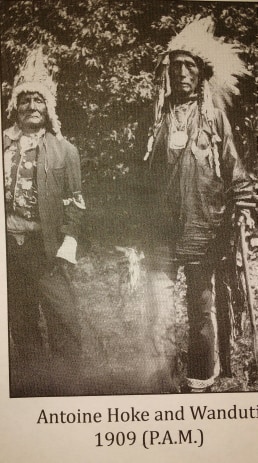
Antoine Hoke and Wanduta, 10 July 1909 - image originally posted by Mitchell BigHunter. amertribes.proboards.com/thread/3205/hoke-antoine-aka-old-james.
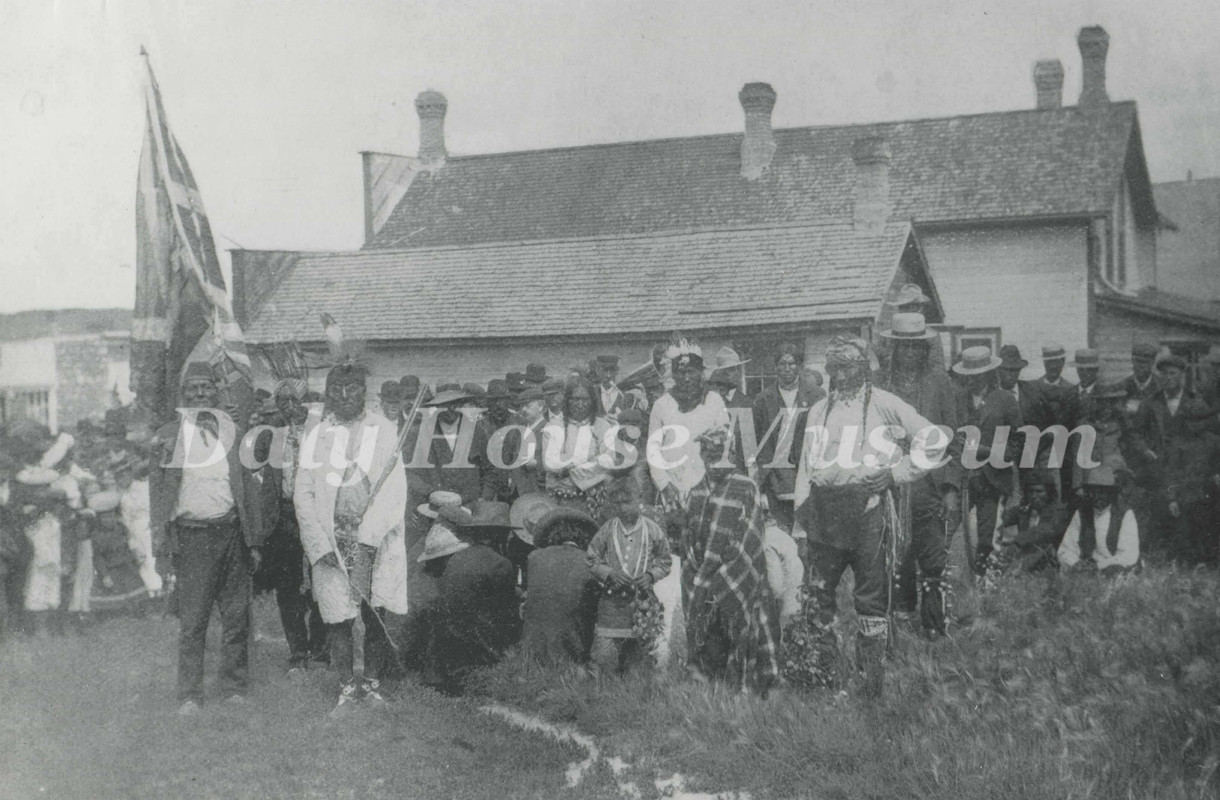
Oak River Dakota at Rapid City. Manitoba, 1901. The man at the left with the revolver is Antoine Hoke/Hoke Antoine/James Antoine.
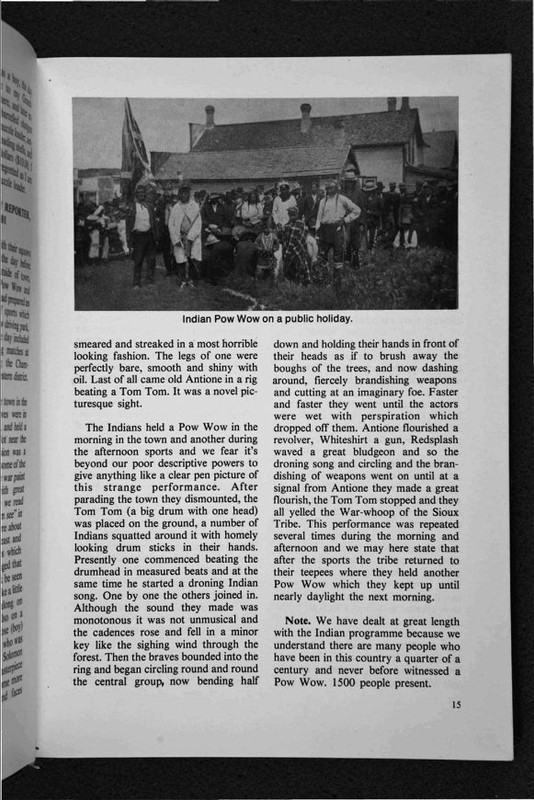
This was posted by Mitchell BigHunter in his thread about Antoine. I can't see the 'great bludgeon' but that must be Whiteshirt wearing the goggles and carrying a Winchester.
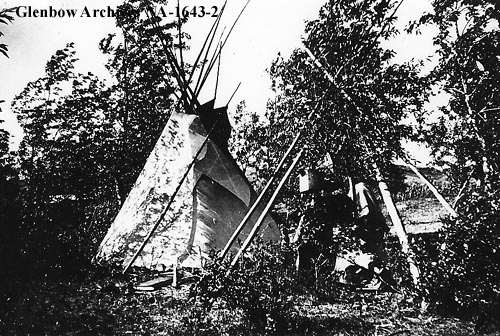
Dakota tipi at Oak River.

Dakota men at the Brandon Fair, Manitoba, 1916; photo by Clark J. Smith.
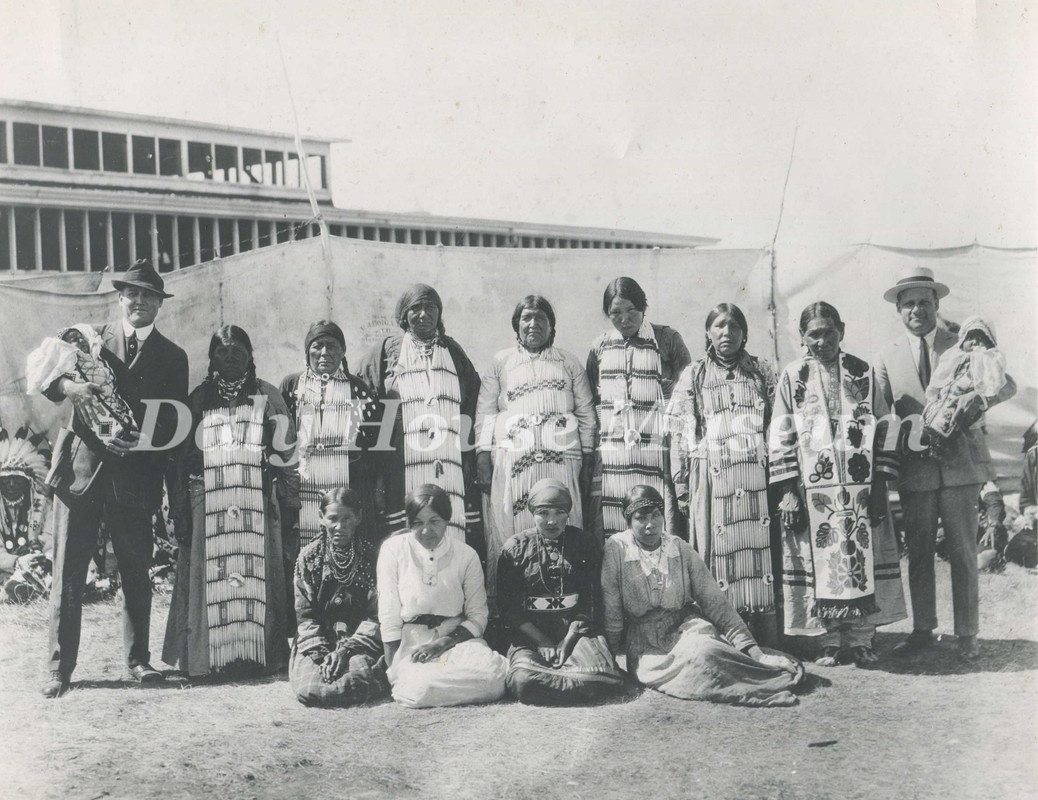
Dakota (?) women at the 1916 Brandon Fair; photo by Smith.
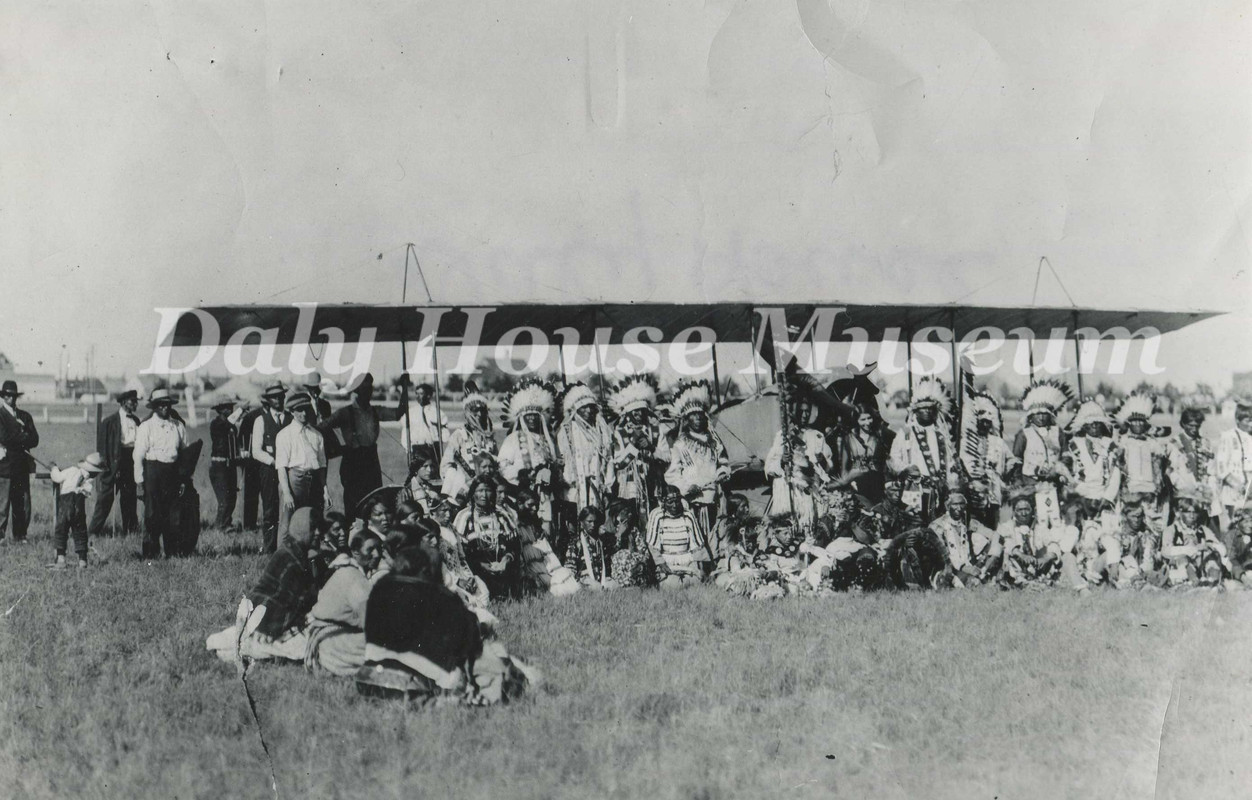
Aviator Katherine Stinson at the Brandon Fair with Dakota people, 1916.
The Daly House Museum images immediately above come from dalyhousemuseum.ca/archival-collections/
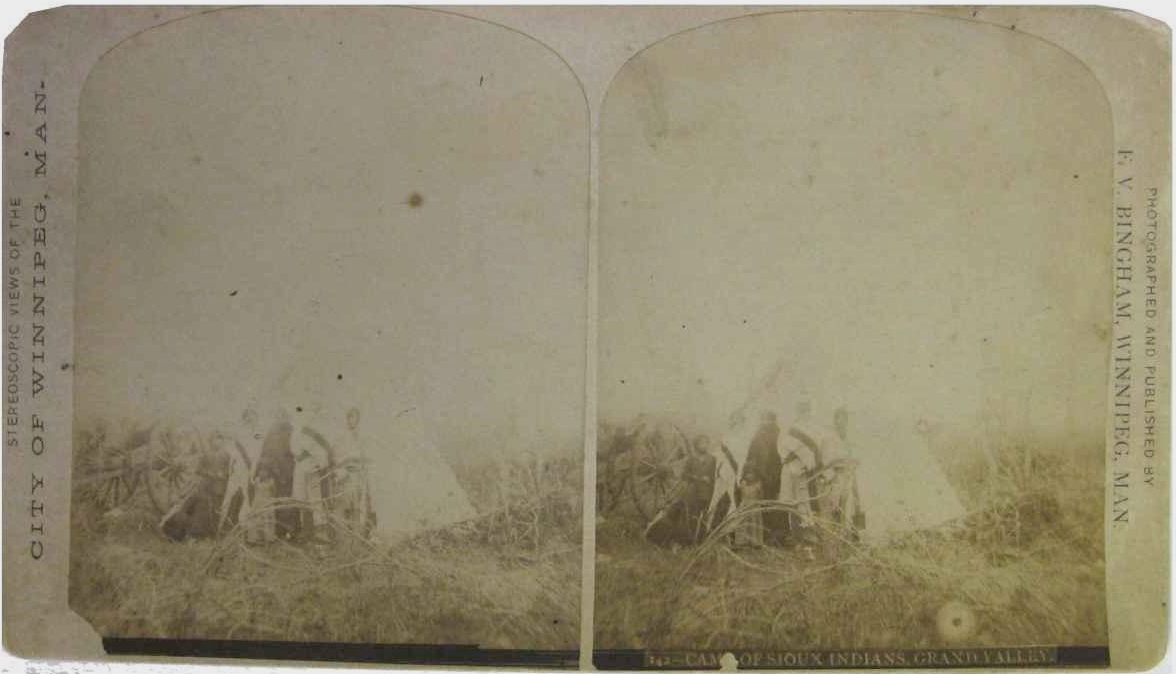
Camp of Sioux - likely Dakota - in the Grand Valley, near Brandon, Manitoba. Photo by F.V. Bingham, who was working at Winnipeg between 1881 and 1886.

Bohpa, from the Birdtail Reserve - image taken from Mitchell bigHunter's thread: amertribes.proboards.com/thread/3209/bohpa-shoots-hits-target
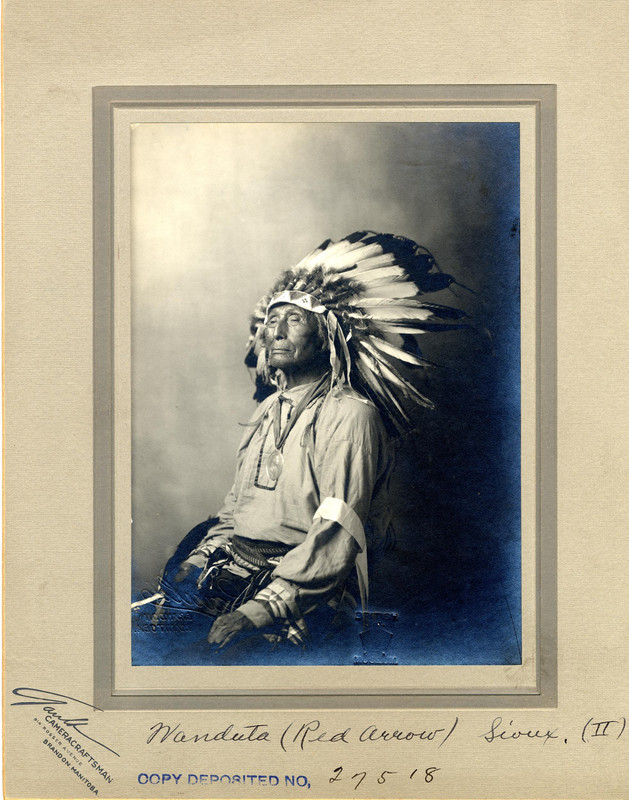
Wanduta or Red Arrow from the Oak Lake area - one of a series of portraits taken by Gould (maybe Harry W. Gauld) of Brandon, Manitoba in 1913. This, three other variants and the four images below are in The British Museum. www.britishmuseum.org/collection/term/BIOG189310
![]()
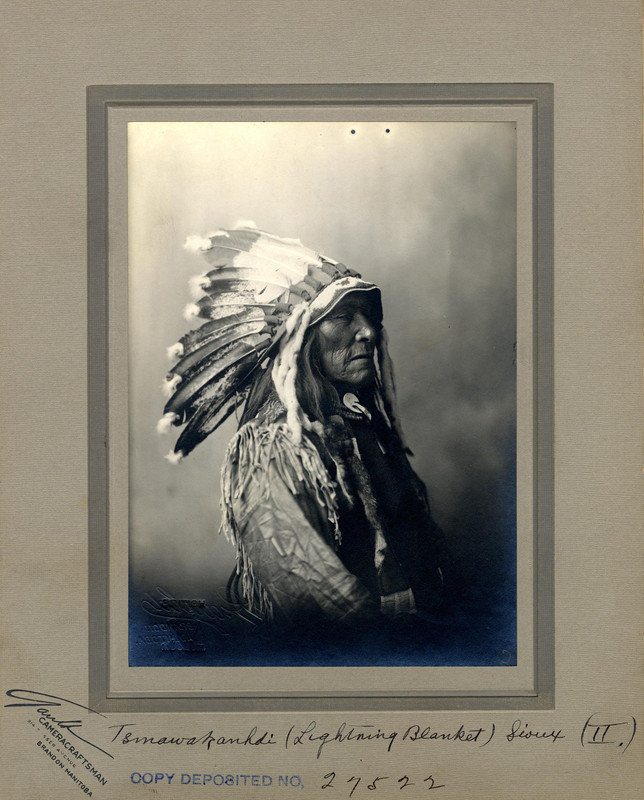
Tsinawakanhdi (Lightning Blanket), a Dakota Sioux man, also photographed in 1913 by Gould/Gauld.
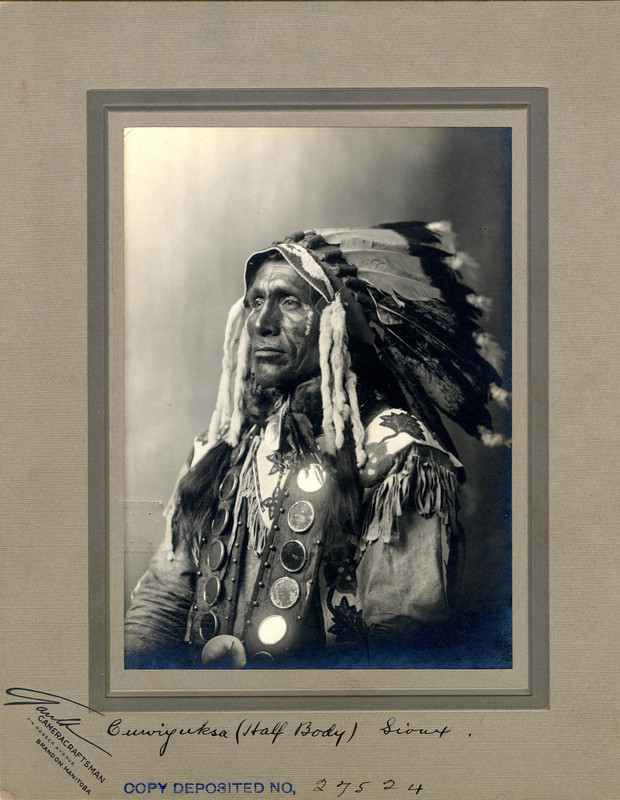
Half Body (Curwiyuksa), Dakota Sioux, by Gould/Gauld, 1913.
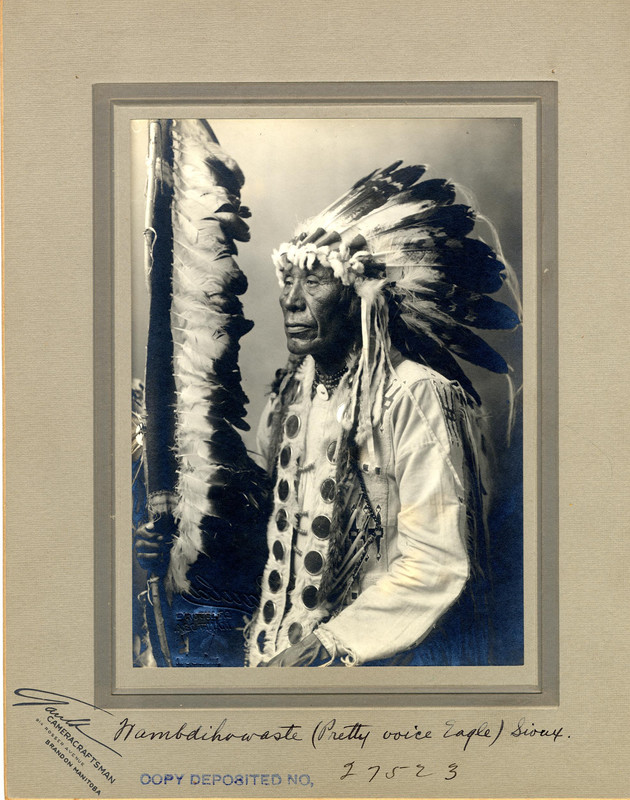
Pretty Voice Eagle (Wambdihowaste), Dakota Sioux, Gould/Gauld, 1913.
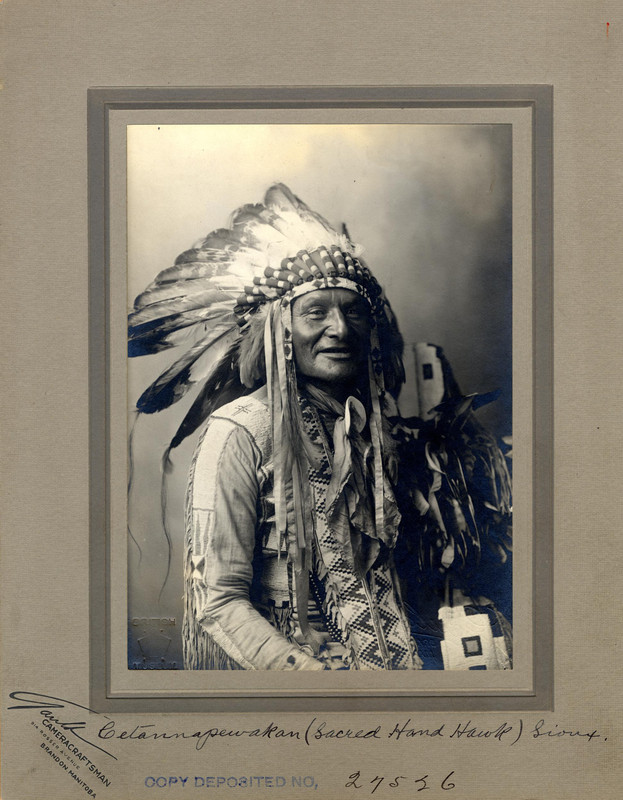
Sacred Hand Hawk (Cetannapewakan) , a Dakota Sioux; Gould/Gauld, 1913.
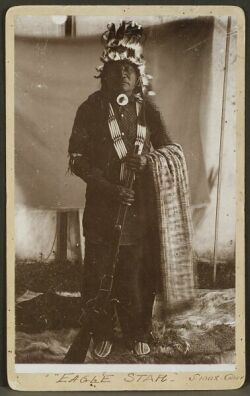
Eagle Star - I had this filed as an image from Canada, but I can't find the source; however, it's not Paul Eagle Star who worked with The Wild West Show as he died young, in Sheffield, England.

Mosawahoh, one of Iyanki's Wahpeton at Prince Albert, Saskatchewan, 1885. The written inscription notes he was a 'loyal Sioux.'
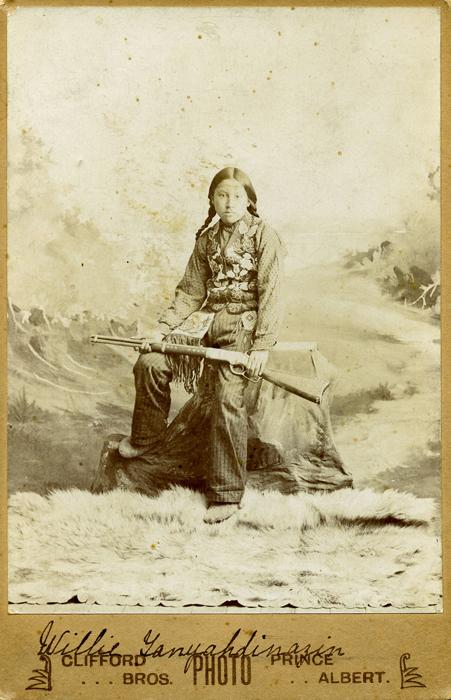
Willie Tanyahdinazin, by Clifford Brothers of Prince Albert.
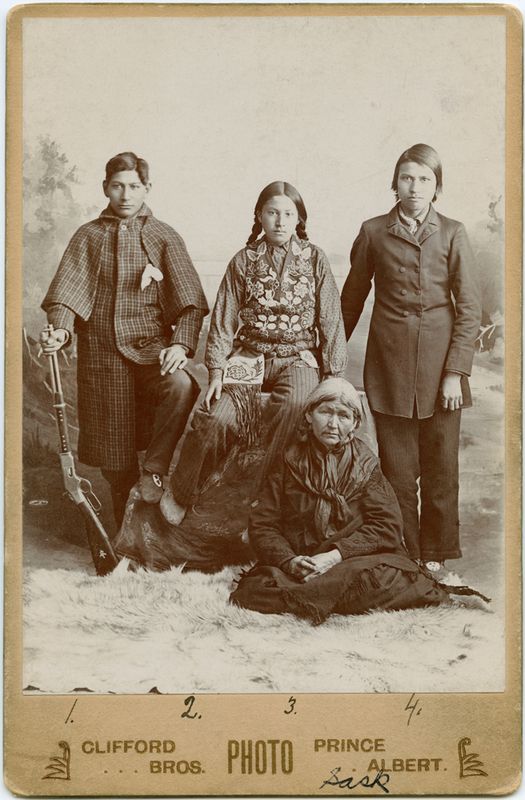
Tacankuwaste, Tanyahdinazin, Tatetankawi Winona, Owacinduta.
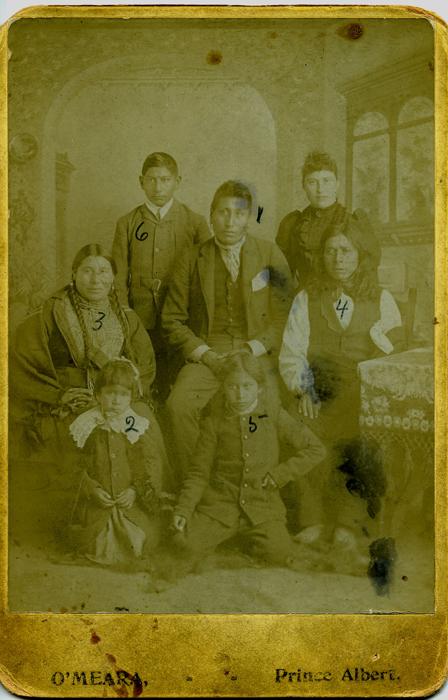
1. He Cantiduka, 2. Pteduatawin, 3. Aki Hotunwin, 4. Ojanjan Kuna, 5. Hante, 6. Tacanku Waste, 7. Mani Duzahanwin (Miss Annie Cameron).
Two of the three images above come from Documenting the Dakota www.saskarchives.com/dakota_Intro_Essay

Ne-raiph-ah-shaw, Sioux man; photographed by Davidson Brothers, Brandon, Manitoba, between 1892 and 1912.

Unidentified 'Sioux' woman; Davidson Brothers, Brandon.

Farming on the Oak River Dakota reserve in southwestern Manitoba.

Unidentified.
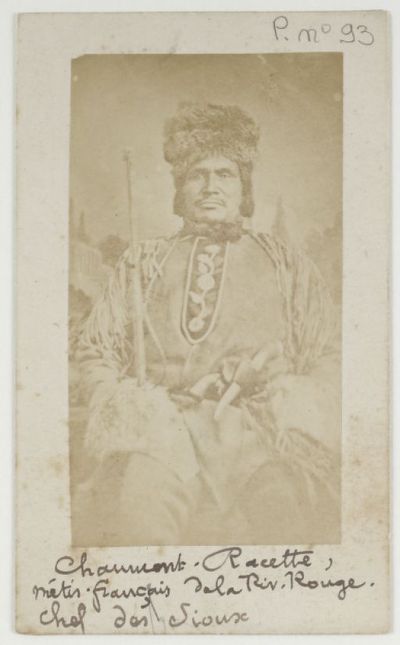
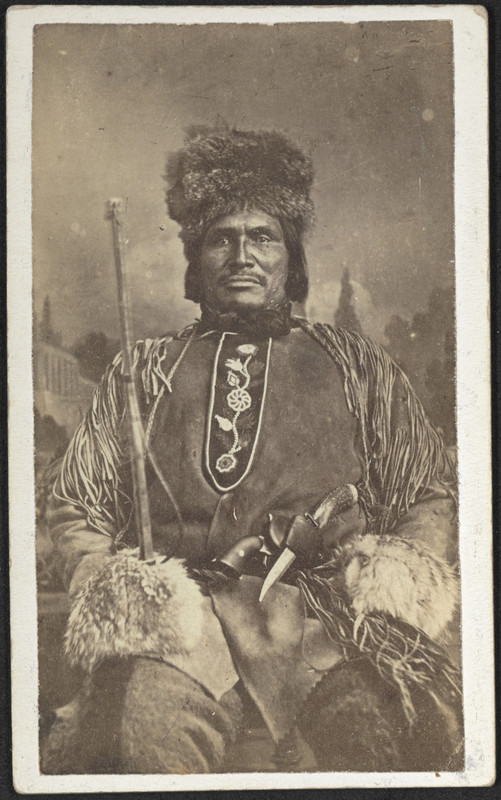
Georges Racette, 1821-1877. 'Chaumont' is a misspelling of 'Cheman' - 'canoe man' in Saulteaux. 'Chef des Sioux'? He was clearly affiliated with one band - or maybe an Assiniboine group; see the article below.
 www.metismuseum.ca/media/document.php/07240.Georges%20Racette.pdf
www.metismuseum.ca/media/document.php/07240.Georges%20Racette.pdf
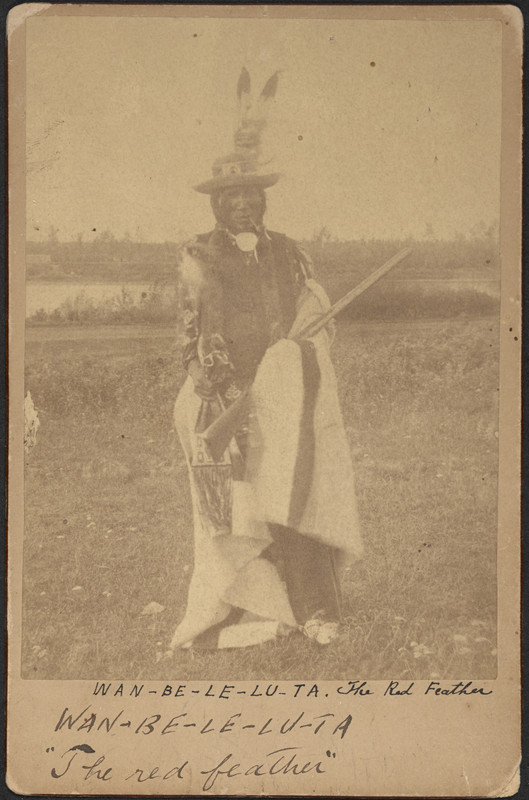
Red Feather - note the Teton dialect. I first saw this on an auction site with the watermark obscuring some of the image. This version - as are a handful of the other images - is from here archive.org/details/bpsc_indigenous_photographs?&sort=-week&page=1
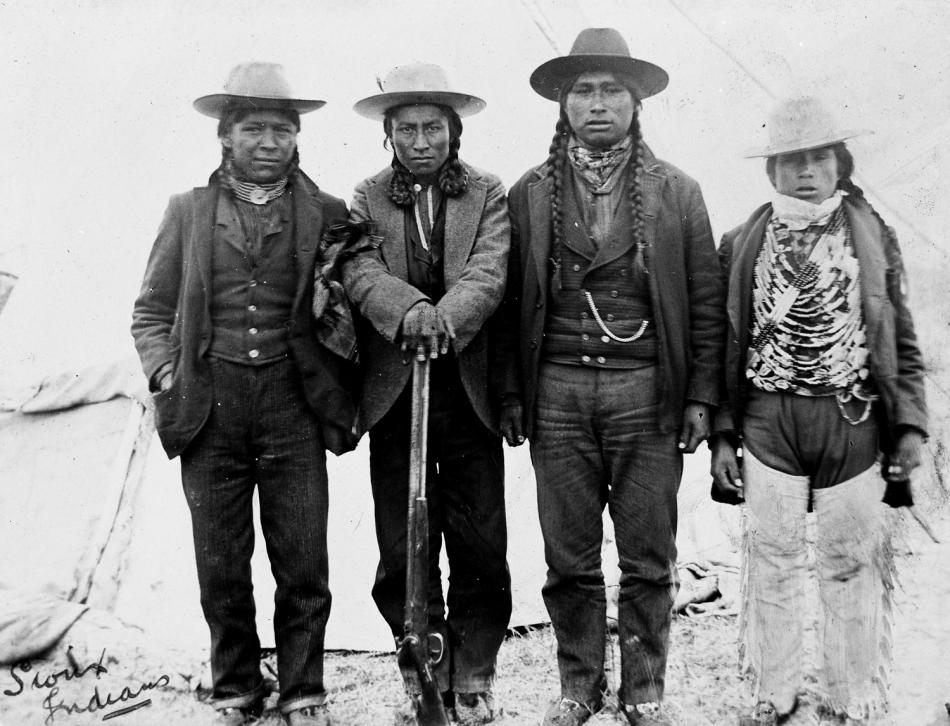
Dakota, Prince Albert district between, 1901 (photo by T.H.J. Charmbury) . L-R: Naji or Standing, Omani or Walking, Hanyetumani or Night Walking and Falling Water (Dakota name illegible).
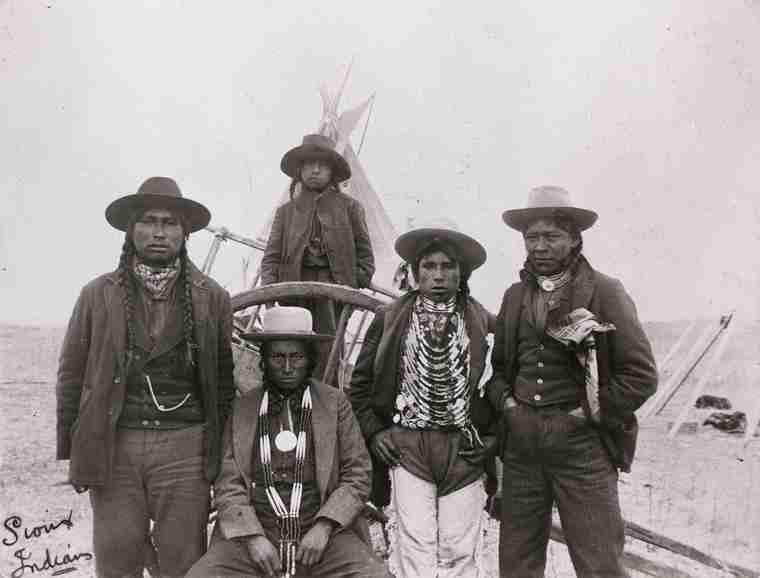
Aa above.
 #
#
Falling Water, by Charmbury, 1901.
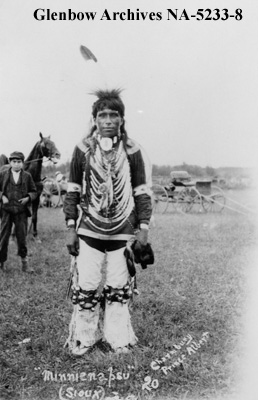
'Minnienapsu' - Falling Water again? (Charmbury, 1901).
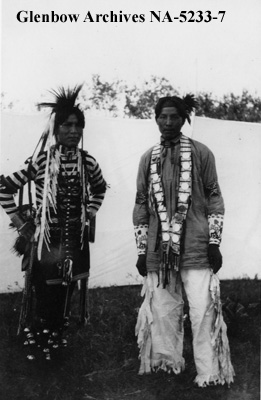
'Wadetaka' and unidentified - by Charmbury, 1901.
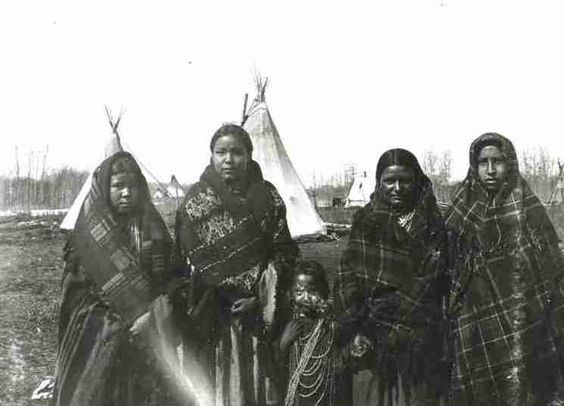
Wahpeton women and child, near Prince Albert (another Charmbury).
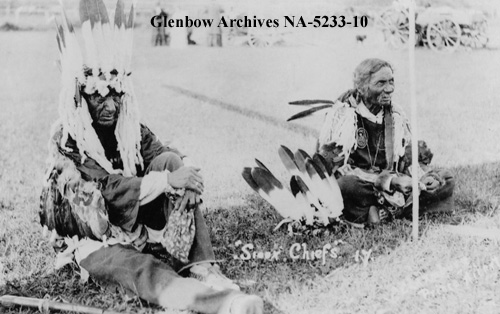
'Tommah Stoyemaza' and unidentified.
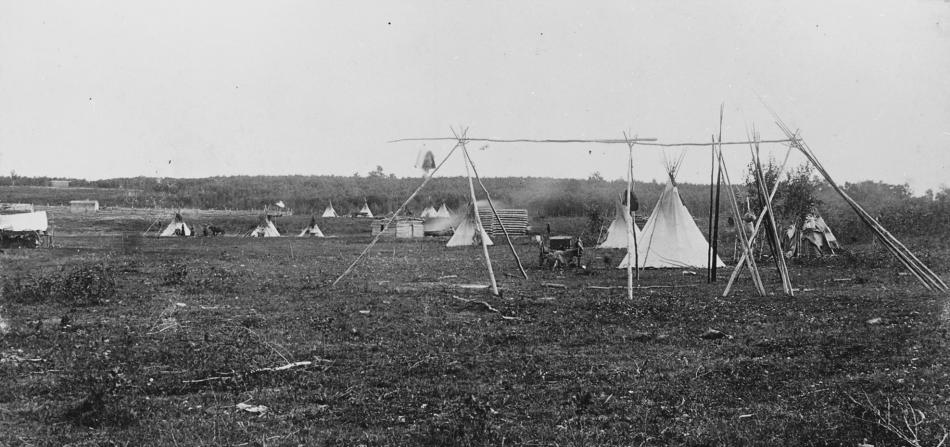
Another Charmbury, between 1900 and 1918.
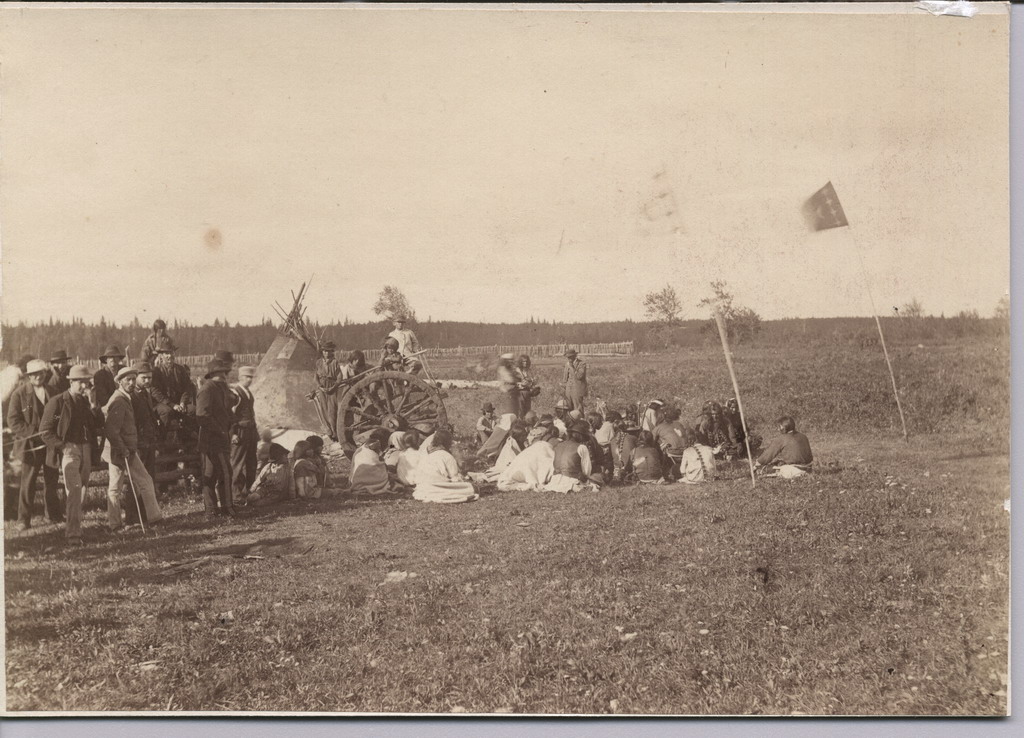
Wahpeton group, Prince Albert area - possibly from the 1880s.
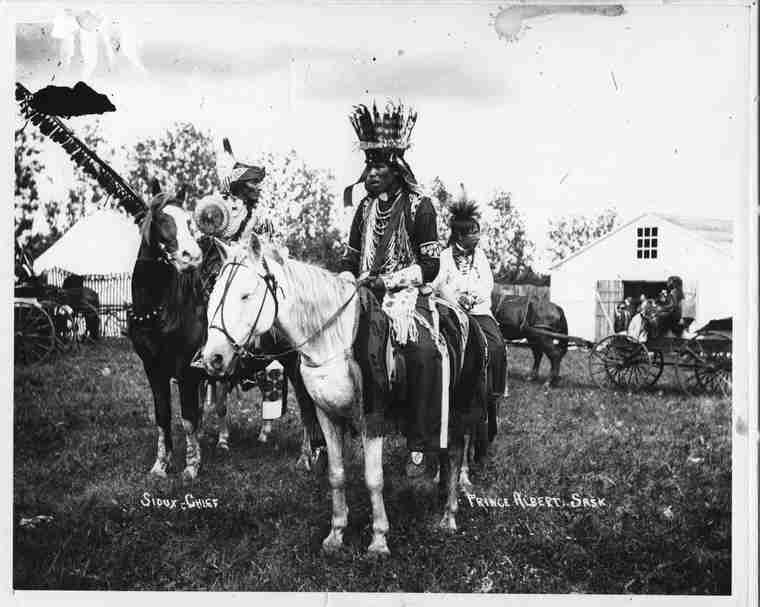
Prince Albert ‘Sioux’ - presumably Wahpeton.
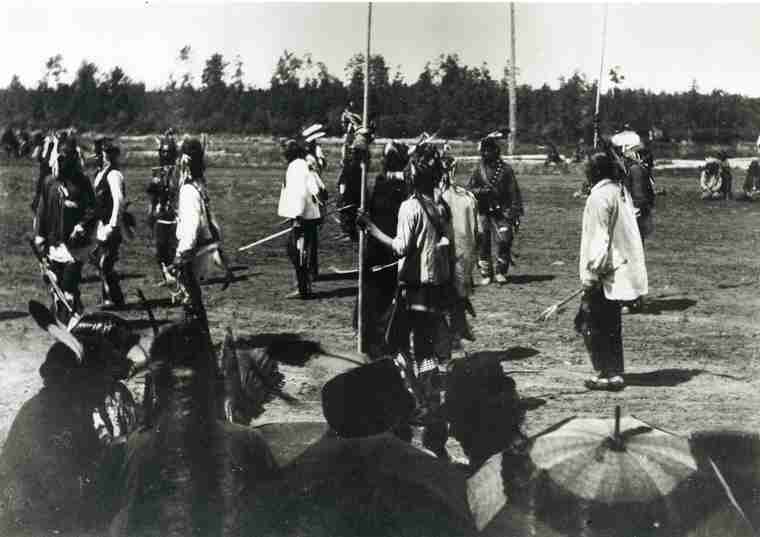
Wahpeton, Prince Albert - a Charmbury photo, 1901.
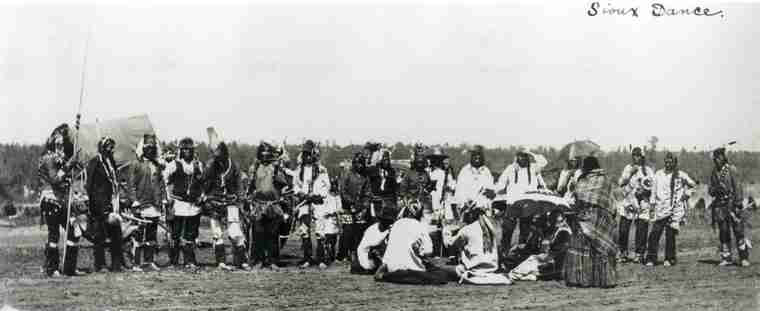
Dakota dance near Prince Albert, 1901. Photo by Charmbury.
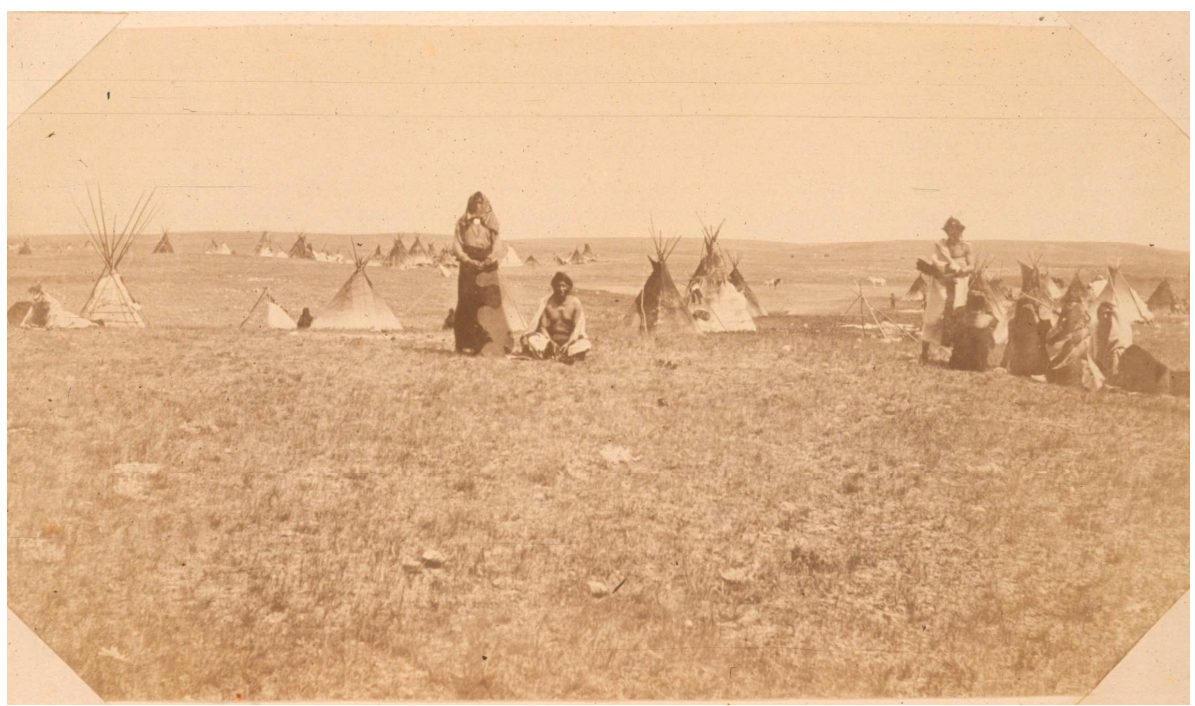
Boundary Survey photo from 1874, showing a Struck by the Ree and Two Dogs' Yanktonai village, 1874. The identification comes from here - www.academia.edu/39254881/The_Boundary_Commissions_Metis_Scouts_The_49_th_Rangers_British_Canadian_Boundary_Commission_1873_74_
However, if it is Struck by the Ree than it's a Yankton village.
Unfortunately, later in the same text, the same image is also identified as an Assiniboine village and it is clearly listed as ‘[Assiniboine] Indian Camp in [Manitoba], July 17, 1874’ here recherche-collection-search.bac-lac.gc.ca/fra/accueil/notice?app=FonAndCol&IdNumber=3248510
In June 1874, one of the Boundary Commission, Lieutenant Valentine Francis Rowe from the Royal Engineers, fell from his horse and recuperated among the Yankton. During that time, he made some paintings of his hosts.

Struck by the Ree and Two Dogs at Short Creek, 1874.
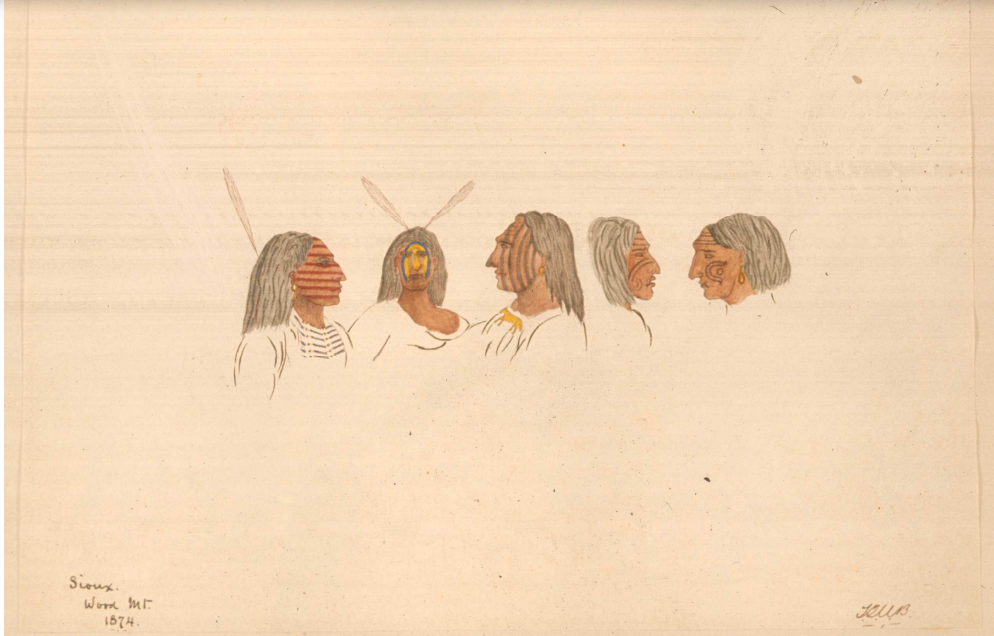
Yankton(?) at Wood Mountain, 1874.
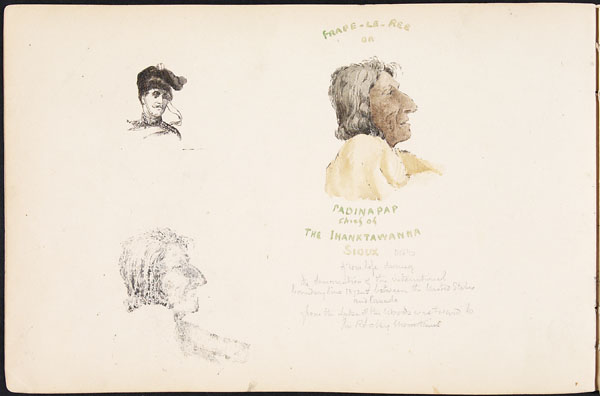
On the same expedition, Donald Roderick Cameron made this sketch of a ‘Portrait of a guardsman, and two portraits of Frape-le-ree or Padinapap, Chief of the Ihanktawanna Sioux’ – i.e. Struck by the Ree of the Yankton. Cameron had been appointed British Boundary Commissioner by the British Foreign Office and oversaw the International Boundary Survey from 1872 to 1876.
recherche-collection-search.bac-lac.gc.ca/fra/accueil/notice?app=FonAndCol&IdNumber=3020957
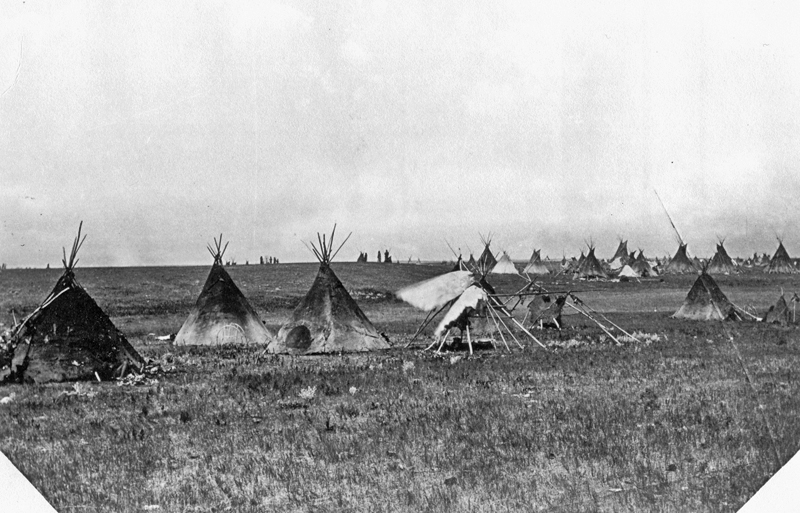
Yanktonai – or Assiniboine - camp, Frenchman’s Creek, Boundary Survey, 1873. However, it is clearly listed as Assiniboine Indian Camp, Lac de Marons, Manitoba, July 17, 1874 here recherche-collection-search.bac-lac.gc.ca/fra/accueil/notice?app=FonAndCol&IdNumber=3248508

Yanktonai or Assiniboine camp, July 7, 1873.
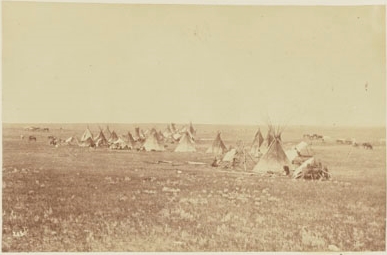
A similar image to the one above, from the Boundary Commission album.
Camp of Assiniboine Indians, Lac de Marons (Manitoba), 17 July, 1874
recherche-collection-search.bac-lac.gc.ca/fra/accueil/notice?app=FonAndCol&IdNumber=5110201


Dakota village, Turtle Mountain, 1873 Boundary Survey; Chief H'Damani is seen here third from the right. The man with the pipe has been named as Bogaga. His manner of dress compared to all the others is interesting, to say the least - unless this refers to the man with the pipe at the right of the image. The other members of the camp were away hunting.
For some Turtle Mountain history see vantagepoints.ca/
For more on the survey see www.academia.edu/39254881/The_Boundary_Commissions_Metis_Scouts_The_49_th_Rangers_British_Canadian_Boundary_Commission_1873_74_
Artist Henri Julien accompanied the NWMP on their journey west:
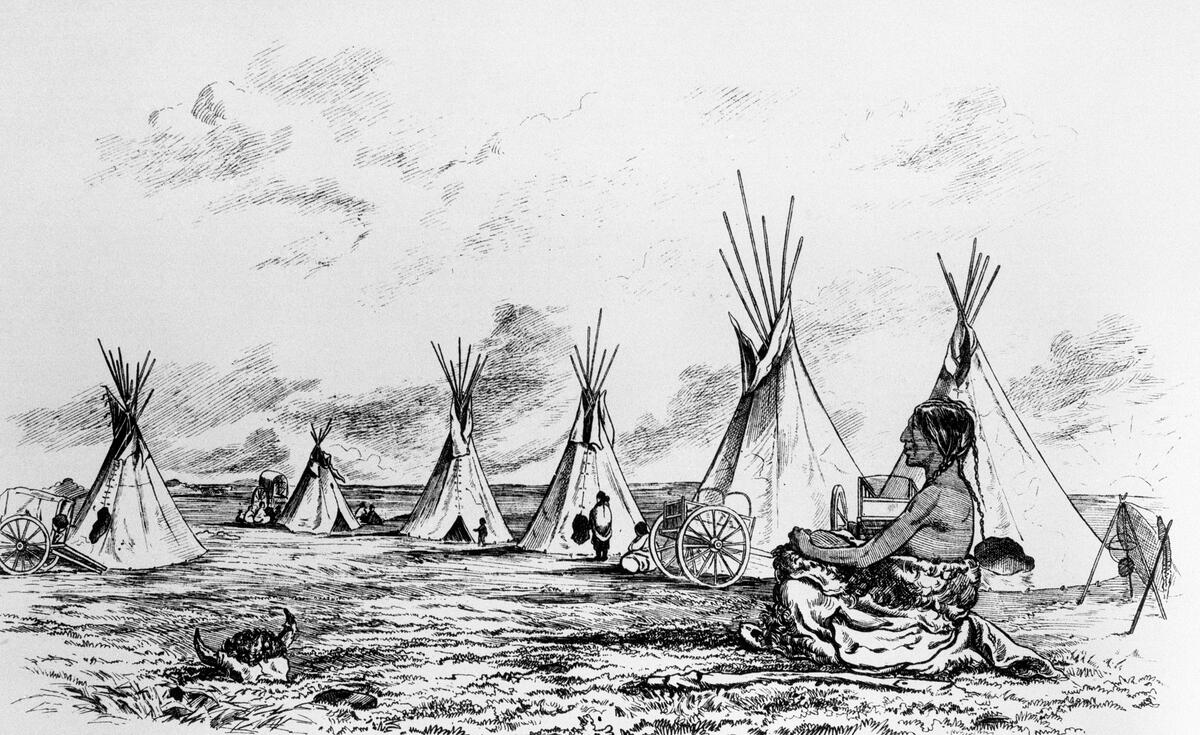
Henri Julien: Yanktonai (surely Yankton if it is Struck by the Ree) camp on Old Wives Creek, Saskatchewan
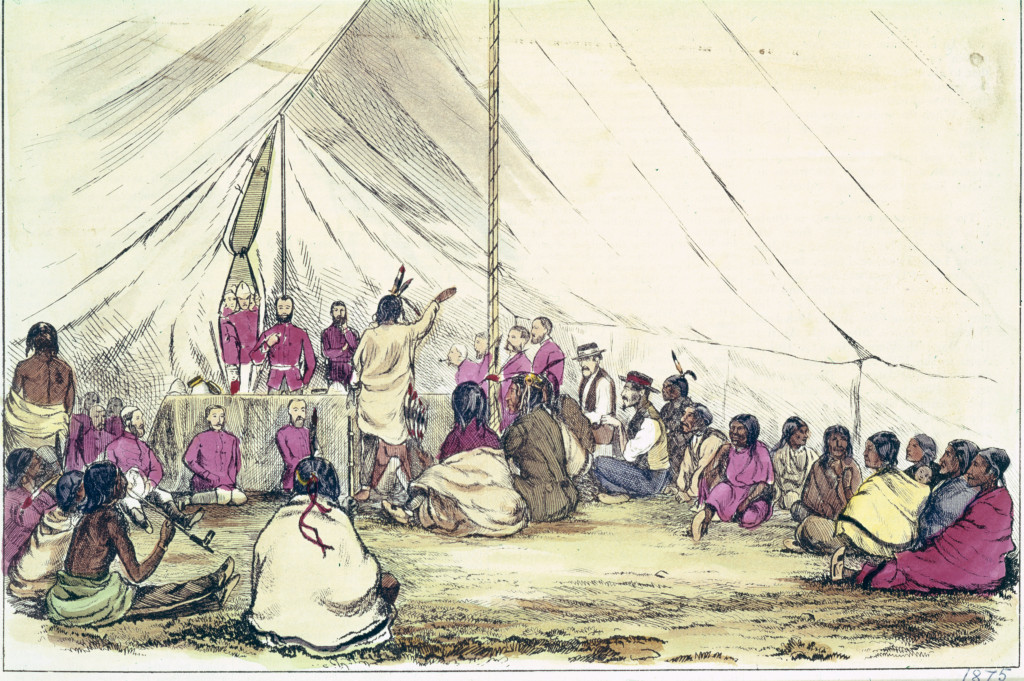
Henri Julien: Council with the 'Sioux'. This seems to be with the Yankton under Two Dogs and Struck by the Ree.
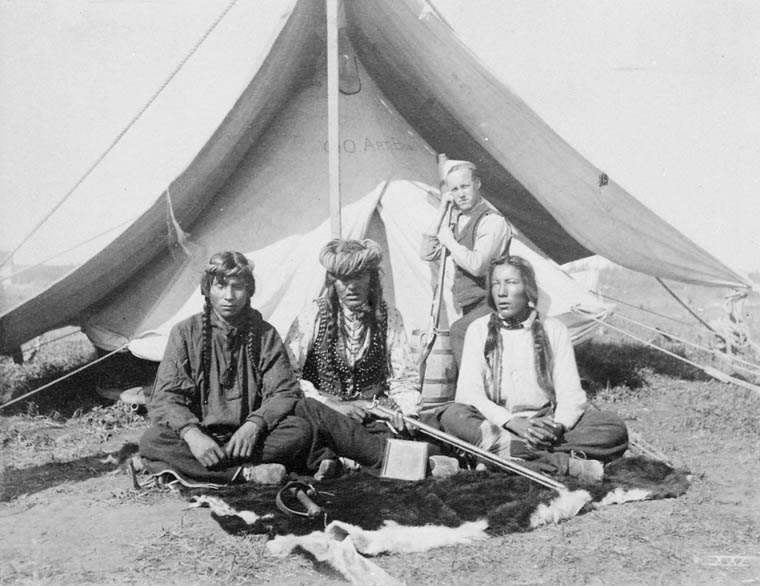
'Sioux' scouts at Prince Albert, 1885 – However, I've also seen them labelled as Cree.

Tasunke Hota or Grey Horse, Prince Albert, 1901 - a Charmbury photo.
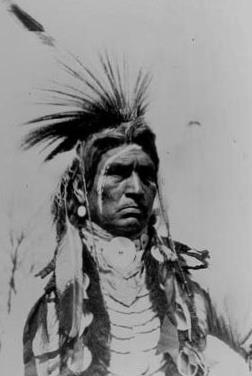
Jim Sapa/Jim Black, Sisseton, post-1910.
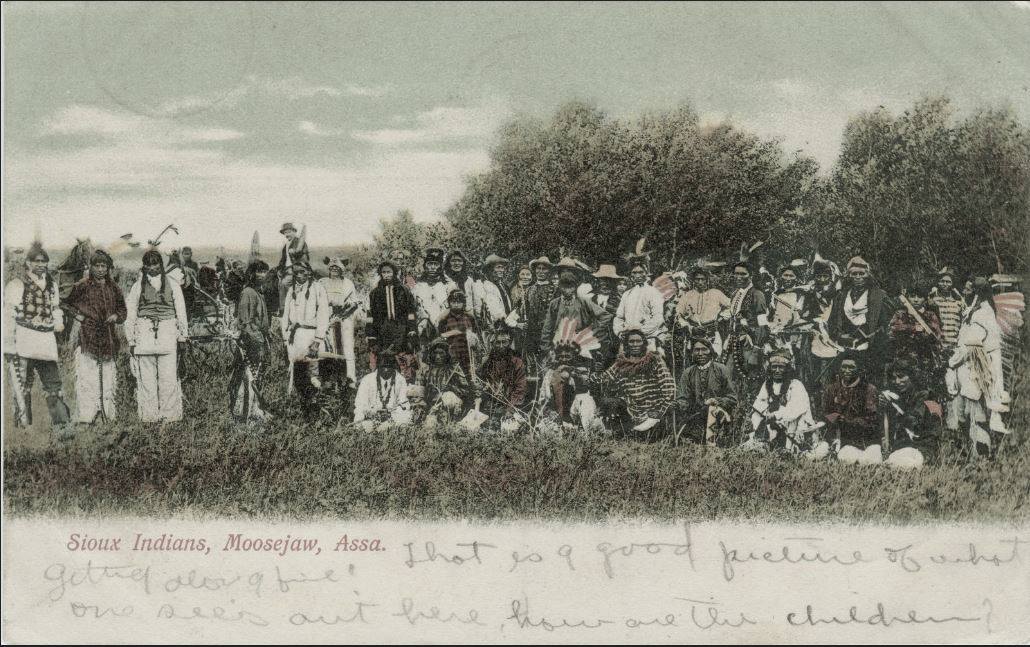
‘Sioux’ at Moose Jaw, 1903.
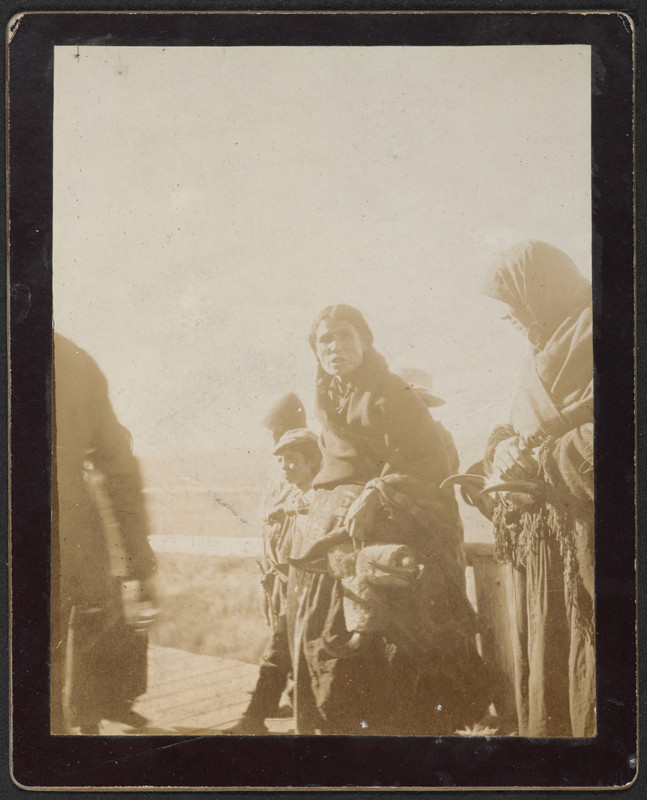
'Sioux' or Assiniboine women carrying polished buffalo horns for sale at Moose Jaw.

'Sioux' at Prince Albert, 1910 - 1920.

Dakota dance at Prince Albert; photo by Charmbury, 1901.
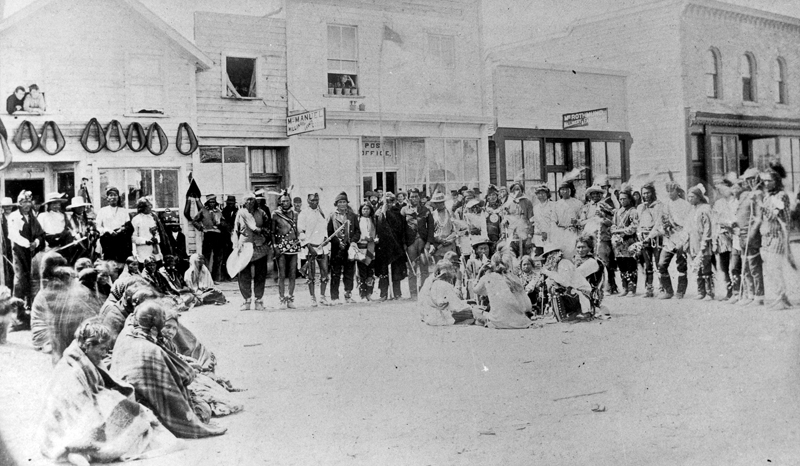
Dakota dance at Virden, Manitoba, 1887.

Dakota?
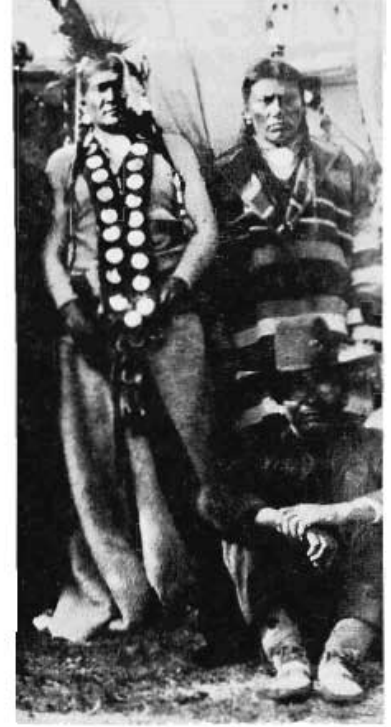
Image taken from Roy Meyer's The Canadian Sioux: collections.mnhs.org/MNHistoryMagazine/articles/41/v41i01p013-028.pdf
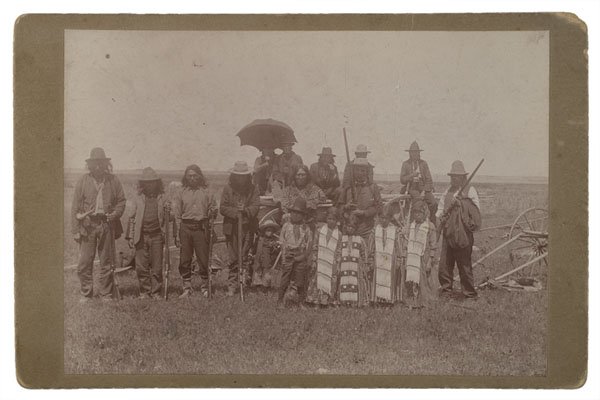
Saskatchewan, early 1900s.
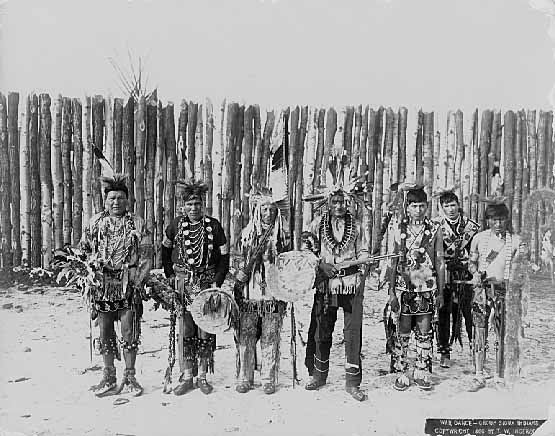
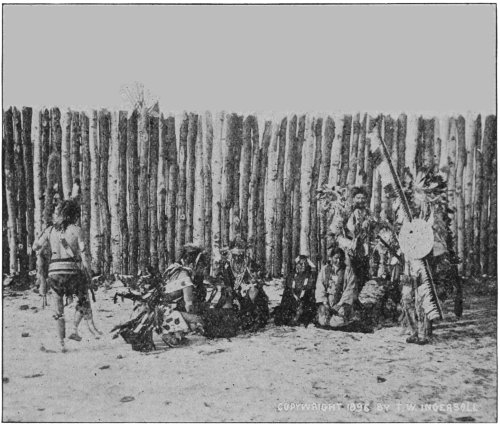
'Sioux,' 1896; photo by Truman Ward Ingersoll.

Sitting Eagle (formerly “Chaske [Charles] Eagle” of Sioux Valley). See moncurgallery.org/council-stones-sitting-eagle/

Possibly the wife of Sitting Eagle, last Dakota Peace Chief of Turtle Mountain. The same man as above?
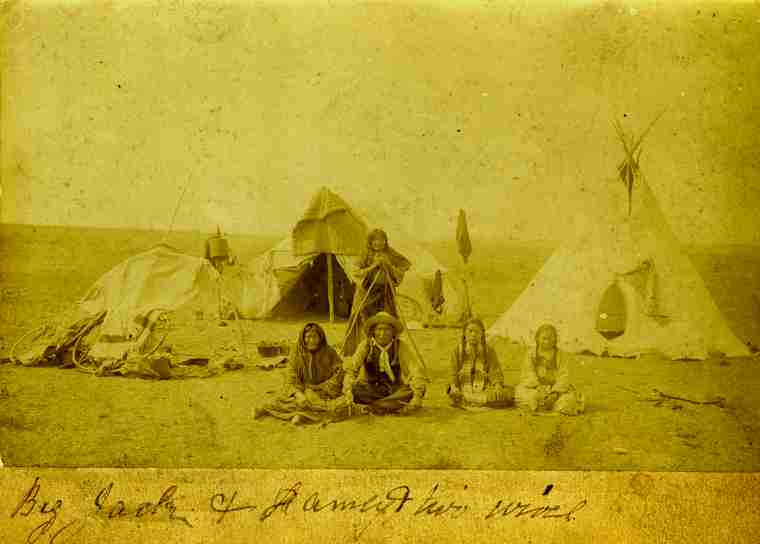
‘Big Jack’ and his two wives. As in several other cases throughout the West, White people seemed to have a paucity of nicknames for native people - like Captain Jack, Crazy Jack, Big Joe, Hooker Jim, Sioux Jim, Bob Brave Bear, Washington, Johnson - and so on... I wonder if this is the 'Sioux Jack' who lived on the Birdtail Reserve and whom Mitchell BigHunter refers to here: amertribes.proboards.com/thread/3344/big-jack-sioux
On the other hand, when I first came across the photo, it was identified as being taken at Moose Jaw.

Tawasuota/Many Hailstones , Dakota. This is the man who allegedly fired the first shot in the Minnesota War. The image was posted by Mitchell BigHunter here: amertribes.proboards.com/thread/3167/tawasuota-hailstones
As he says, he’s not 100% sure it is him and I have to admit that I've seen the image identified as an Anishinaabe man. According to texts he’d seen (by Robert Goodvoice), this man (here, called Tarasota) led his Dakota to the Prince Albert area after the Minnesota War, but not until around 1875. He died on Birdtail Creek in 1902.
The Goodvoice text: ourspace.uregina.ca/bitstream/handle/10294/2286/IH-111.pdf?sequence=1&isAllowed=y
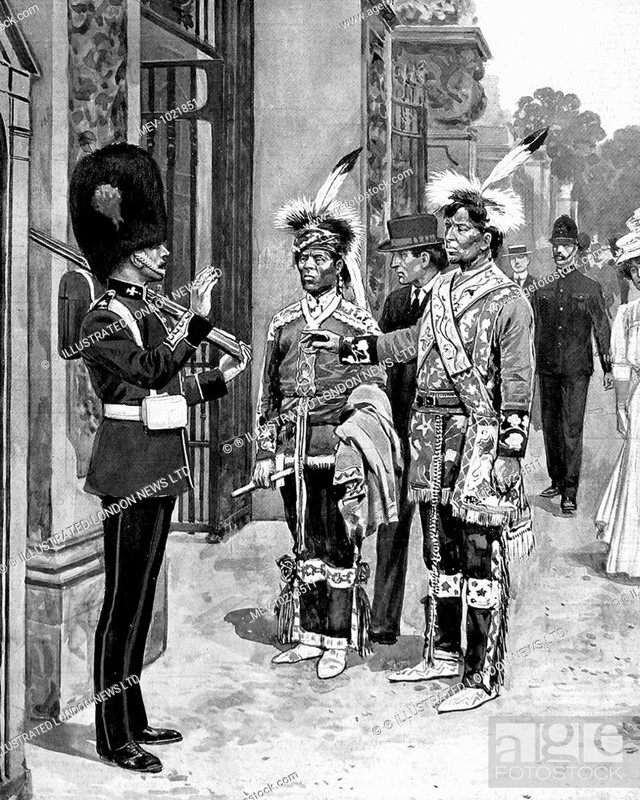
Two Sioux Dakota headmen, Akish'ya and George Kiyiwakan, outside Buckingham Palace in London to air their grievances against the Canadian Government. Image originally published in The Illustrated London News, 1907. The guardsman is supposedly stopping the men from getting in to see Edward VII...
Both men were freom the Oak River Reserve and had been politically active earlier. In 1893, Kiyiwakan (Kiyewakan, also known as George Kiyewakan) and others had travelled to Ottawa without an interpreter to lodge a complaint about the way the reserve was being run; in 1903 he, Akish'ya (Akisa), Pazaiyapa, Wasticaka and Hoksidaska had hired a lawyer to secure the release of Wanduta who had been imprisoned for continuing Dakota dances at various fairs when the government had passed legislation prohibiting them.
books.openedition.org/uop/470#tocfrom1n5
More later...
This is a selection of photographs of Dakota/Lakota people in Canada, taken largely between 1870 and 1915. Most of them aren't in any sense rare - quite a few can be found at The Glenbow site ( digitalcollections.ucalgary.ca/asset-management/2R340826N9XM?WS=PackagePres&Flat=1&FR_=1&W=1280&H=569 ) - and it’s by no means complete; documentation is often poor, hence the use of the word, 'Sioux,' in inverted commas and sometimes even that might not be correct. Where subjects are named, I’ve simply used the spelling as given. On top of that, many of the people, more especially females, are, unfortunately, not named. Perhaps this is a result of 'Indians' being seen at least initially, as exotic subject matter for the photographers to sell. Canadian photographers Hall and Lowe, for example, advertised 'Indian photos (taken from life), Xmas cards, views of Winnipeg.'
To give an example of how little care was taken in terms of naming subjects correctly, this is The Evening Journal from May 1886, a year after Otto Buell had photographed the Crees, Big Bear and Poundmaker, and the Dakota, White Cap, at their trial - yet the image used to illustrate Poundmaker has been taken from a Goff or Haynes photograph of a Lakota (or possibly a Yanktonai)...

It's not even as if he looks anything like Poundmaker:

The Goff or Haynes photo

The real Poundmaker
The names of some of the photographers are unknown so it's not always possible to come up with even a rough date for some of the pictures.
Having said all that, however, here they are (along with the odd painting and drawing)...

Two 'Sioux' at Fort Garry, Winnipeg; painted by Paul Kane, 1846.
Although usually considered to be 'American,' the Dakota/Lakota wandered back and forth between the United States and Canada for many years before the exodus following Little Crow's war to hunt, trade and fight.
David McCrady's dissertation on which he based his book, Living with Strangers: The Nineteenth Century Sioux and the Canadian-American Borderlands, can be found in pdf form here: www.collectionscanada.gc.ca/obj/s4/f2/dsk2/tape17/PQDD_0027/NQ32884.pdf
Katie Pollock's dissertation that looks at the history of the Metis and their relationship with the tribes in the 'borderlands' of Canada and the USA: From Borderlands to Bordered Lands: The Plains Metis and the 49th Parallel, 1869‐1885: www.academia.edu/11090653/_From_Borderlands_to_Bordered_Lands_the_Plains_Metis_and_the_49th_parallel_1869_1885_M_A_Thesis_History_and_Classics_University_of_Alberta_2009_
Delia Lee Hagen's dissertation, Northern Plains Borders and the People in Between, 1860-1940:
digitalassets.lib.berkeley.edu/etd/ucb/text/Hagen_berkeley_0028E_15256.pdf

Unidentified Dakota family. Photo by J.A. Brock and Company, Brandon, Manitoba, probably between 1883-1889. However, I’ve seen the same image credited to the Davidson Brothers, also of Brandon, but they didn’t start their business until 1892 so it could well be a later date.

Iron Buffalo, Wahpeton - taken at Prince Albert by Theodore Charmbury, circa 1905.

Iron Buffalo - as above.

"Sioux" chief, Prince Albert, early 1900s.

Dakota with pipe of peace, Prince Albert, early 1900s. I think this is Iron Buffalo again.

'Sioux' medicine man at Qu'Appelle.

Unidentified - Red River Dakota, Manitoba; taken by Simon Duffin of Winnipeg, between 1873-1888.

Antoine Hoke, 10 July 1909. I wonder if this is the same Antoine who was a member of White Eagle's band and vsited Lieutenant Governor Alexander Morris at Fort Garry to ask for a reserve on the Assiniboine River in 1874...

Antoine Hoke and Wanduta, 10 July 1909 - image originally posted by Mitchell BigHunter. amertribes.proboards.com/thread/3205/hoke-antoine-aka-old-james.

Oak River Dakota at Rapid City. Manitoba, 1901. The man at the left with the revolver is Antoine Hoke/Hoke Antoine/James Antoine.

This was posted by Mitchell BigHunter in his thread about Antoine. I can't see the 'great bludgeon' but that must be Whiteshirt wearing the goggles and carrying a Winchester.

Dakota tipi at Oak River.

Dakota men at the Brandon Fair, Manitoba, 1916; photo by Clark J. Smith.

Dakota (?) women at the 1916 Brandon Fair; photo by Smith.

Aviator Katherine Stinson at the Brandon Fair with Dakota people, 1916.
The Daly House Museum images immediately above come from dalyhousemuseum.ca/archival-collections/

Camp of Sioux - likely Dakota - in the Grand Valley, near Brandon, Manitoba. Photo by F.V. Bingham, who was working at Winnipeg between 1881 and 1886.

Bohpa, from the Birdtail Reserve - image taken from Mitchell bigHunter's thread: amertribes.proboards.com/thread/3209/bohpa-shoots-hits-target

Wanduta or Red Arrow from the Oak Lake area - one of a series of portraits taken by Gould (maybe Harry W. Gauld) of Brandon, Manitoba in 1913. This, three other variants and the four images below are in The British Museum. www.britishmuseum.org/collection/term/BIOG189310

Tsinawakanhdi (Lightning Blanket), a Dakota Sioux man, also photographed in 1913 by Gould/Gauld.

Half Body (Curwiyuksa), Dakota Sioux, by Gould/Gauld, 1913.

Pretty Voice Eagle (Wambdihowaste), Dakota Sioux, Gould/Gauld, 1913.

Sacred Hand Hawk (Cetannapewakan) , a Dakota Sioux; Gould/Gauld, 1913.

Eagle Star - I had this filed as an image from Canada, but I can't find the source; however, it's not Paul Eagle Star who worked with The Wild West Show as he died young, in Sheffield, England.

Mosawahoh, one of Iyanki's Wahpeton at Prince Albert, Saskatchewan, 1885. The written inscription notes he was a 'loyal Sioux.'

Willie Tanyahdinazin, by Clifford Brothers of Prince Albert.

Tacankuwaste, Tanyahdinazin, Tatetankawi Winona, Owacinduta.

1. He Cantiduka, 2. Pteduatawin, 3. Aki Hotunwin, 4. Ojanjan Kuna, 5. Hante, 6. Tacanku Waste, 7. Mani Duzahanwin (Miss Annie Cameron).
Two of the three images above come from Documenting the Dakota www.saskarchives.com/dakota_Intro_Essay

Ne-raiph-ah-shaw, Sioux man; photographed by Davidson Brothers, Brandon, Manitoba, between 1892 and 1912.

Unidentified 'Sioux' woman; Davidson Brothers, Brandon.

Farming on the Oak River Dakota reserve in southwestern Manitoba.

Unidentified.


Georges Racette, 1821-1877. 'Chaumont' is a misspelling of 'Cheman' - 'canoe man' in Saulteaux. 'Chef des Sioux'? He was clearly affiliated with one band - or maybe an Assiniboine group; see the article below.
 www.metismuseum.ca/media/document.php/07240.Georges%20Racette.pdf
www.metismuseum.ca/media/document.php/07240.Georges%20Racette.pdf
Red Feather - note the Teton dialect. I first saw this on an auction site with the watermark obscuring some of the image. This version - as are a handful of the other images - is from here archive.org/details/bpsc_indigenous_photographs?&sort=-week&page=1

Dakota, Prince Albert district between, 1901 (photo by T.H.J. Charmbury) . L-R: Naji or Standing, Omani or Walking, Hanyetumani or Night Walking and Falling Water (Dakota name illegible).

Aa above.
 #
#Falling Water, by Charmbury, 1901.

'Minnienapsu' - Falling Water again? (Charmbury, 1901).

'Wadetaka' and unidentified - by Charmbury, 1901.

Wahpeton women and child, near Prince Albert (another Charmbury).

'Tommah Stoyemaza' and unidentified.

Another Charmbury, between 1900 and 1918.

Wahpeton group, Prince Albert area - possibly from the 1880s.

Prince Albert ‘Sioux’ - presumably Wahpeton.

Wahpeton, Prince Albert - a Charmbury photo, 1901.

Dakota dance near Prince Albert, 1901. Photo by Charmbury.

Boundary Survey photo from 1874, showing a Struck by the Ree and Two Dogs' Yanktonai village, 1874. The identification comes from here - www.academia.edu/39254881/The_Boundary_Commissions_Metis_Scouts_The_49_th_Rangers_British_Canadian_Boundary_Commission_1873_74_
However, if it is Struck by the Ree than it's a Yankton village.
Unfortunately, later in the same text, the same image is also identified as an Assiniboine village and it is clearly listed as ‘[Assiniboine] Indian Camp in [Manitoba], July 17, 1874’ here recherche-collection-search.bac-lac.gc.ca/fra/accueil/notice?app=FonAndCol&IdNumber=3248510
In June 1874, one of the Boundary Commission, Lieutenant Valentine Francis Rowe from the Royal Engineers, fell from his horse and recuperated among the Yankton. During that time, he made some paintings of his hosts.

Struck by the Ree and Two Dogs at Short Creek, 1874.

Yankton(?) at Wood Mountain, 1874.

On the same expedition, Donald Roderick Cameron made this sketch of a ‘Portrait of a guardsman, and two portraits of Frape-le-ree or Padinapap, Chief of the Ihanktawanna Sioux’ – i.e. Struck by the Ree of the Yankton. Cameron had been appointed British Boundary Commissioner by the British Foreign Office and oversaw the International Boundary Survey from 1872 to 1876.
recherche-collection-search.bac-lac.gc.ca/fra/accueil/notice?app=FonAndCol&IdNumber=3020957

Yanktonai – or Assiniboine - camp, Frenchman’s Creek, Boundary Survey, 1873. However, it is clearly listed as Assiniboine Indian Camp, Lac de Marons, Manitoba, July 17, 1874 here recherche-collection-search.bac-lac.gc.ca/fra/accueil/notice?app=FonAndCol&IdNumber=3248508

Yanktonai or Assiniboine camp, July 7, 1873.

A similar image to the one above, from the Boundary Commission album.
Camp of Assiniboine Indians, Lac de Marons (Manitoba), 17 July, 1874
recherche-collection-search.bac-lac.gc.ca/fra/accueil/notice?app=FonAndCol&IdNumber=5110201


Dakota village, Turtle Mountain, 1873 Boundary Survey; Chief H'Damani is seen here third from the right. The man with the pipe has been named as Bogaga. His manner of dress compared to all the others is interesting, to say the least - unless this refers to the man with the pipe at the right of the image. The other members of the camp were away hunting.
For some Turtle Mountain history see vantagepoints.ca/
For more on the survey see www.academia.edu/39254881/The_Boundary_Commissions_Metis_Scouts_The_49_th_Rangers_British_Canadian_Boundary_Commission_1873_74_
Artist Henri Julien accompanied the NWMP on their journey west:

Henri Julien: Yanktonai (surely Yankton if it is Struck by the Ree) camp on Old Wives Creek, Saskatchewan

Henri Julien: Council with the 'Sioux'. This seems to be with the Yankton under Two Dogs and Struck by the Ree.

'Sioux' scouts at Prince Albert, 1885 – However, I've also seen them labelled as Cree.

Tasunke Hota or Grey Horse, Prince Albert, 1901 - a Charmbury photo.

Jim Sapa/Jim Black, Sisseton, post-1910.

‘Sioux’ at Moose Jaw, 1903.

'Sioux' or Assiniboine women carrying polished buffalo horns for sale at Moose Jaw.

'Sioux' at Prince Albert, 1910 - 1920.

Dakota dance at Prince Albert; photo by Charmbury, 1901.

Dakota dance at Virden, Manitoba, 1887.

Dakota?

Image taken from Roy Meyer's The Canadian Sioux: collections.mnhs.org/MNHistoryMagazine/articles/41/v41i01p013-028.pdf

Saskatchewan, early 1900s.


'Sioux,' 1896; photo by Truman Ward Ingersoll.

Sitting Eagle (formerly “Chaske [Charles] Eagle” of Sioux Valley). See moncurgallery.org/council-stones-sitting-eagle/

Possibly the wife of Sitting Eagle, last Dakota Peace Chief of Turtle Mountain. The same man as above?

‘Big Jack’ and his two wives. As in several other cases throughout the West, White people seemed to have a paucity of nicknames for native people - like Captain Jack, Crazy Jack, Big Joe, Hooker Jim, Sioux Jim, Bob Brave Bear, Washington, Johnson - and so on... I wonder if this is the 'Sioux Jack' who lived on the Birdtail Reserve and whom Mitchell BigHunter refers to here: amertribes.proboards.com/thread/3344/big-jack-sioux
On the other hand, when I first came across the photo, it was identified as being taken at Moose Jaw.

Tawasuota/Many Hailstones , Dakota. This is the man who allegedly fired the first shot in the Minnesota War. The image was posted by Mitchell BigHunter here: amertribes.proboards.com/thread/3167/tawasuota-hailstones
As he says, he’s not 100% sure it is him and I have to admit that I've seen the image identified as an Anishinaabe man. According to texts he’d seen (by Robert Goodvoice), this man (here, called Tarasota) led his Dakota to the Prince Albert area after the Minnesota War, but not until around 1875. He died on Birdtail Creek in 1902.
The Goodvoice text: ourspace.uregina.ca/bitstream/handle/10294/2286/IH-111.pdf?sequence=1&isAllowed=y

Two Sioux Dakota headmen, Akish'ya and George Kiyiwakan, outside Buckingham Palace in London to air their grievances against the Canadian Government. Image originally published in The Illustrated London News, 1907. The guardsman is supposedly stopping the men from getting in to see Edward VII...
Both men were freom the Oak River Reserve and had been politically active earlier. In 1893, Kiyiwakan (Kiyewakan, also known as George Kiyewakan) and others had travelled to Ottawa without an interpreter to lodge a complaint about the way the reserve was being run; in 1903 he, Akish'ya (Akisa), Pazaiyapa, Wasticaka and Hoksidaska had hired a lawyer to secure the release of Wanduta who had been imprisoned for continuing Dakota dances at various fairs when the government had passed legislation prohibiting them.
books.openedition.org/uop/470#tocfrom1n5
More later...


